Adidas Target Market Segmentation and Marketing Strategy – Audience Demographics & Competitors
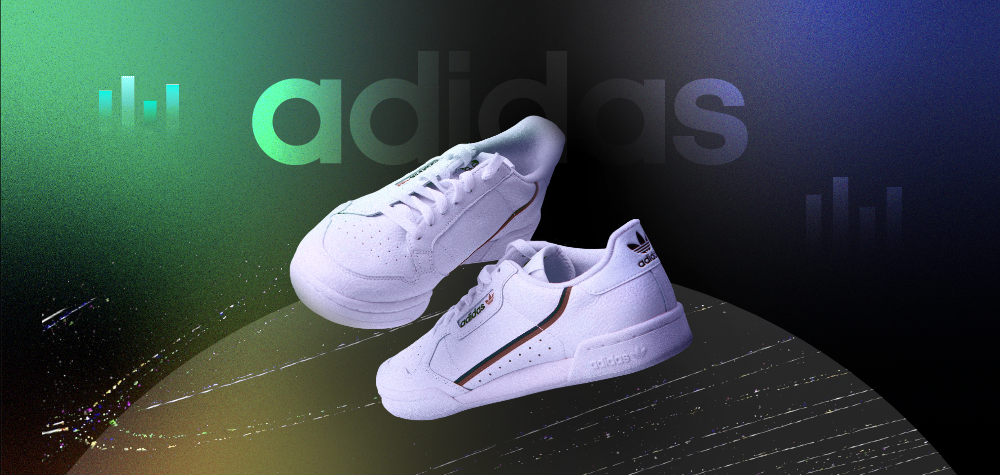
Ever heard of Adolf (“Adi”) Dassler? If not, then you’ve definitely heard of the brand he launched: Adidas.
Founded in Germany in 1948, Adidas today is a leading global company in the sports footwear and apparel category. In a fascinating bit of branding history, Puma – an Adidas competitor – was launched by Dassler’s brother Rudolf. Following a family rift, the brothers split the footwear company founded by their parents, and Adidas and Puma were born.
The Adidas brand has long been synonymous with athletic footwear, such as the Stan Smith sneaker, Adidas’ first tennis shoe.
The Stan Smith was released in 1963, renamed in the early 1970s for the American professional tennis player who held the number 1 world ranking at the time. The iconic shoe features a white leather construction and three stripes on the side that are unmistakably ‘Adidas’.
Half a century later, the Stan Smith remains as popular as ever.
In 2022, it is enjoying a revival with a sustainable edition made from 100% eco-friendly materials, promoted by Stan Smith himself and Kermit the Frog in a green-themed commercial:
Adidas is certainly a modern success story, despite its rocky start as a result of a family argument. In 2021, Adidas had a brand value of over $14.3 billion . That same year, Adidas net global sales amounted to $21.2 billion, slightly below the pre-pandemic peak in 2019, but significantly higher than the $18.4 billion figure from 2020.
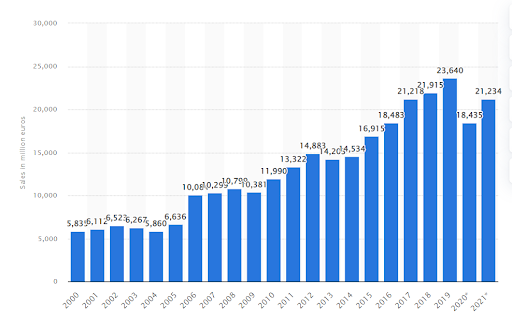
Source – Statista
While Adidas began as a shoe producer, the company slowly expanded into a wide range of sportswear, sporting goods and accessories. In 1963, for example, Adidas began manufacturing soccer footballs . Since 1970, Adidas has been the provider of the official football for the annual FIFA World Cup™.
Footwear remains the largest product category for Adidas, making up 53% of the company’s net sales in 2021. 41% of sales were sports apparel and the remaining 6% on goods and accessories.
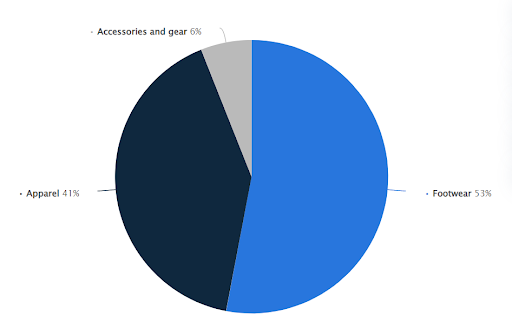
Source – Statista
Who is the loyal Adidas target customer who has helped make it one of the largest sportswear companies in the world? What is the Adidas market segmentation and how does Adidas marketing strategy cater to them? Let’s take a deep dive into an Adidas industry analysis and find out.

Want to learn more?
Who is adidas’ target market.
The Adidas target market is highly active, and includes athletes, as well as non athletes who are enthusiastic about sport . Adidas buyers tend to be between the ages of 14 to 40, though the brand offers clothing and footwear lines for infants and children too .
The Adidas target market is located all over the world, with the largest market share in the EMEA region . Both men and women are targeted by Adidas, with specialized product lines.
The brand’s strongest product category is footwear, and there is a large and fast-growing demand for clothing and apparel. The Adidas target audience also purchases sporting accessories, including sports socks, caps and drinking bottles, and sports equipment, such as footballs and basketballs. However, the accessories and gear category is a much smaller proportion of Adidas overall sales, with a production volume that has remained fairly static over the past half-decade .
Adidas Target Market Segmentation
The target market for Adidas is large and complex. The best way to get to the hearts and minds of potential customers is to do an Adidas customer segmentation, focusing on four different aspects: demographics, geographics, behavioral and psychographic segmentation. Here’s the latest Adidas segmentation:
Adidas Demographic Segmentation
The largest target market for Adidas demographics is aged between 20 and 29, during the stage of life when fitness and sports are typically a high priority. The Adidas strategy has recently become focused on the new generation of up-and-coming sports enthusiasts, strengthening its targeting of the 14 to 19 year-old segment.
The Adidas target audience has traditionally skewed more towards males. However, in recent years, Adidas has stepped up its marketing for the female target market . An example is the award winning “Liquid Billboard” campaign, encouraging women to feel confident while swimming in public.
The Adidas target audience includes singles, married couples without children, and married couples with young to teenage children, who aspire to maintain an athletic lifestyle or image.
Adidas Geographic Segmentation
The Adidas target audience is located internationally, and the company has a market presence in over 160 countries . In 2021, Adidas operated 2,184 retail stores worldwide .
The proportion of Adidas net sales is highest in Europe, the Middle East and Africa (37%), followed by North America with 24% and Greater China at 22% . Smaller markets cover Asia-Pacific and Latin America.
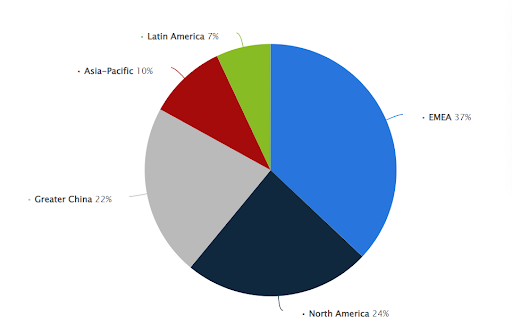
Adidas is a solidly urban brand, with a strong presence in global trend-setting cities. Its state-of-the-art flagship stores are situated in prime locations in London, Paris, NY, LA, Tokyo and Shanghai.
Adidas Behavioral Segmentation
The target market for Adidas is typically sports enthusiasts, amateur athletes and professional athletes, who train or participate in sports on a regular basis . The brand also appeals to those who view sport and fitness as part of their lifestyle and self-image.
Adidas customers are fashion and style conscious, and enjoy popular culture, evident in the company’s frequent collaboration with celebrities, fashion designers and pop culture icons.
Examples include Stella McCartney’s range of women’s sportswear and the Adidas Yeezy line , in partnership with Kanye West.
Adidas Psychographic Segmentation
The personality of the Adidas target customer tends to be active, adventurous and aspirational, with a tech-savvy streak . Usually urban dwelling sports fans, they earn a mid to high average income.
An Adidas study found that sustainability is an important purchasing factor for 70% of consumers. In response, the brand is continuing its sustainability efforts. The company is now working on using recycled plastics from the ocean for its footwear.
Who are Adidas competitors?
Among Adidas competitors, the strongest is of course Nike . Nike easily outperforms Adidas, with a current brand value estimated at over 3x that of Adidas.
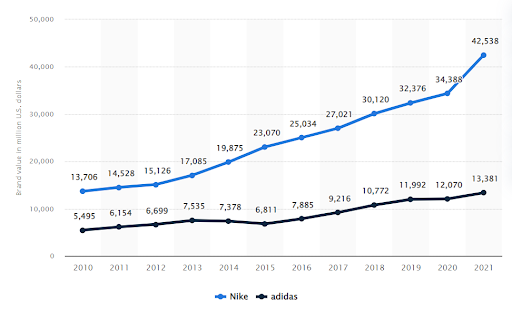
This is also reflected in total sales revenue. In 2021, Adidas ranked as the world’s second largest sportswear company after Nike, whose revenue was nearly double that of Adidas. Interestingly, Puma – established by the brother of the Adidas founder – settled in at number 4.
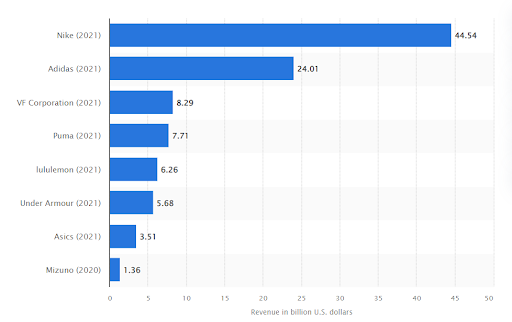
The Nike target market is broader than the target market for Adidas, which accounts for its larger market share and brand value. However, Adidas revenue is 3x ahead of the next closest competitor, VF Corporation , which owns lifestyle brands such as Vans , The North Face , Timberland , Jansport and many more.
Adidas owns the popular Reebok sports footwear brand and was also the owner of TaylorMade, a golf apparel brand, until 2017 . Despite strong competition, Adidas securely holds second place among its competitors as a uniquely iconic sports apparel brand, highly focused on performance, style and innovation.
What is Adidas Marketing Strategy?
Adidas marketing has always placed a strong emphasis on technology and innovation. In 1984, Adidas added the Micropacer to its sneaker, the first tracking device to provide performance data for athletes. This approach continues till today, with the development of Futurecraft 4D STRUNG . Futurecraft 4D is an innovative technology that uses athlete data, 3D printing and robotics to create the optimal personalized shoe to enhance the individual’s sports performance.
Adidas is also renowned for its open source approach, collaborating with innovators to push the boundaries of athletic performance, and advance its brand image at the same time. In 2019 for example, Adidas partnered with the US National Lab of the International Space Station to explore the performance of materials in microgravity, even sending soccer balls to space to test their behavior in weightless conditions.
The innovation extends beyond R&D and product excellence to the in-store customer experience. Adidas’ flagship stores, strategically located in influential urban centers, are fitted with state-of-the-art tech, including interactive fitting rooms.
The Run Genie app was developed as an in-store data-driven sales tool to help sales reps find the perfect shoe for each customer’s unique foot shape and training needs. At the same time, Adidas’ e-commerce business is massively expanding. Sales on the adidas.com website have doubled since 2020, reaching nearly $3.1 billion in 2022 . Most sales occur in the US .
Digital marketing is a significant part of Adidas marketing strategy, with 90% of the marketing budget spent on digital and social campaigns .
For example, the adiClub loyalty app enables US customers to accrue points, which can be redeemed for a range of rewards and offers. It also offers free shipping on online purchase, and members only access to exclusive products and new releases.
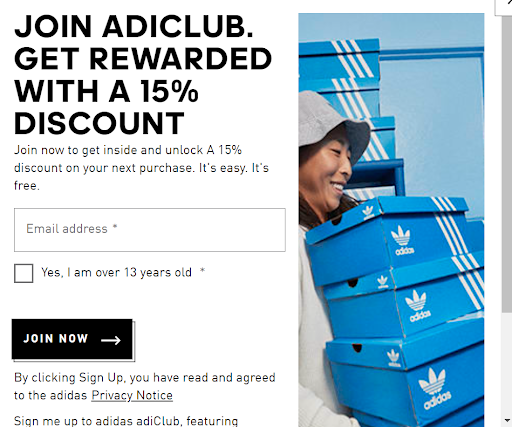
The character of the Adidas brand is clear in its slogan – Impossible is nothing – which was first created in 1974, taken from a quote by boxing legend Mohammed Ali.
The recent “Run for the Oceans” campaign is a great example of Adidas branding. It combines the company’s slogan with a commitment to sustainability, ending plastic waste and saving the oceans – all popular messages among the Adidas target audience.
The campaign was a partnership between Adidas and Parley for the Ocean . Together, they committed to cleaning up the weight equivalent of one plastic bottle for every 10 minutes of running logged by campaign participants on the Adidas Running app.
Check out the Adidas advertisement for the “Run for the Oceans” campaign:
Although Adidas branding is powerfully synonymous with sports, it does an excellent job marketing itself as a fashion leader. In 2022, the company partnered with Gucci to create a collection of fashion inspired by an archival Adidas advertising catalog from 1979.
The Gucci x Adidas collaboration blends the two design signatures of these historic brands in an exclusive and highly sought after sports-fashion collection.
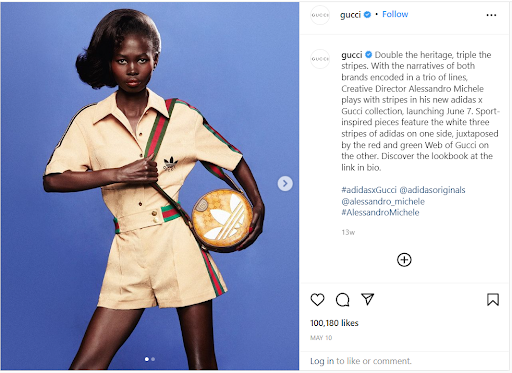
Understanding Adidas’ goals and Adidas growth strategy can help other businesses in the sports and apparel industry learn how to boost their marketing too. Combined with an Adidas market segmentation analysis, this provides powerful insights about how to better manage customer targeting.
For the sports apparel industry, and 500+ industries and niches, the Start.io Consumers Insights and Audiences Hub provides audience data from hundreds of countries and cities worldwide. Simply apply the relevant filters and gain access to relevant business insights to create better advertising campaigns and targeting. Goal!
Adidas FAQs
What age group does adidas target.
Adidas targets consumers aged roughly 14 to 40, with a stronger emphasis on the segment aged between 20 and 29.
Where is Adidas most popular?
Adidas net sales are highest in the EMEA region, covering Europe, the Middle East and Africa. North America and Greater China have similar market share, with Asia-Pacific and Latin America the least popular regions for the Adidas brand.
What is Adidas unique selling point?
Adidas has a strong brand image around the theme of athletic performance. The company invests significantly in R&D, tech innovation and mutual collaborations to advance the performance and excellence of its products and brand image.
In addition, the company is very style-focused, partnering with high profile designers and celebrities to extend its fashion-first concept to the world of athletics and sports.
Who is Adidas biggest competitor?
Nike is Adidas biggest competitor, with significantly higher brand value and net revenue compared to Adidas. Nevertheless, Adidas holds strong in its position as the second-largest sportswear brand in the world, with triple the market share compared to the next closest competitor, VF Corporation.

Google I/O 2024: Our top 6 takeaways for Android app developers

New study: The most popular languages in the United States (other than English and Spanish)

For the first time, advertisers will spend more on CTV ads than traditional TV, report says
Privacy Overview
Adidas Marketing Strategy: Blending Innovation With Heritage for the Win
Adidas, the renowned sportswear and lifestyle brand, has been able to capture the market with its effective marketing strategy . Understanding the Adidas brand is crucial to comprehending the success behind its marketing efforts. By examining the history of Adidas and its brand identity , we can gain insight into the foundations that have propelled its marketing strategy to new heights.
Understanding the Adidas Brand
Adidas traces its origins back to the early 20th century when it was founded by Adolf Dassler. Over the years, the brand has evolved and grown exponentially, becoming synonymous with innovation and quality in the sports industry. The Adidas brand stands for performance , style, and authenticity, making it a favorite among athletes and trendsetters alike.
When it comes to the history of Adidas, there is a fascinating story that dates back to 1924. It all started when Adolf Dassler, a passionate shoemaker, decided to establish a small shoe manufacturing company in Germany. Little did he know that this humble beginning would pave the way for a global sports empire.
Adidas gained international recognition during the 1954 FIFA World Cup, which was held in Switzerland. The German national team, wearing Adidas boots, achieved an unexpected victory against the heavily favored Hungarian team. This triumph not only shocked the football world but also propelled the Adidas brand into the spotlight. Suddenly, athletes and sports enthusiasts around the globe were eager to get their hands on the same boots that had led to such an incredible victory.
With its newfound reputation, Adidas began collaborating with top athletes and teams across various sports. From football to basketball, tennis to running, Adidas became the go-to brand for professional athletes seeking performance-enhancing gear. The brand's commitment to quality and innovation ensured that athletes could rely on Adidas products to help them reach their full potential.
The History of Adidas
Adidas has a rich history that dates back to 1924, when Adolf Dassler started a small shoe manufacturing company in Germany. The brand gained international recognition during the 1954 FIFA World Cup when the German national team won while wearing Adidas boots. This success further propelled the brand's reputation, leading to collaborations with top athletes and teams across various sports.
As the years went by, Adidas continued to innovate and expand its product range. The brand introduced groundbreaking technologies such as Boost cushioning, which revolutionized the comfort and performance of running shoes. Adidas also ventured into the world of fashion, collaborating with renowned designers and celebrities to create stylish and trendsetting collections.
Adidas' commitment to sustainability has also played a significant role in shaping its history. The brand has implemented initiatives to reduce its environmental impact, such as using recycled materials in its products and promoting responsible manufacturing practices. This dedication to sustainability has not only earned Adidas praise from consumers but has also positioned the brand as a leader in corporate social responsibility.
Adidas' Brand Identity
The Adidas brand is built on a foundation of innovation, quality, and a commitment to excellence. With its iconic three-stripe logo, Adidas has successfully created a strong brand identity that resonates with consumers. The brand's focus on performance-driven products, combined with its sense of style and fashion, has allowed Adidas to establish itself as a leader in the sportswear market.
Adidas understands that athletes and sports enthusiasts not only want gear that enhances their performance but also reflects their personal style. That is why the brand continuously collaborates with designers, artists, and celebrities to create limited-edition collections that merge sports and fashion seamlessly. These collaborations have resulted in iconic products that have become coveted items among sneakerheads and fashion enthusiasts.
Furthermore, Adidas' commitment to authenticity sets it apart from its competitors. The brand stays true to its roots and heritage, paying homage to its founder, Adolf Dassler, and the legacy he left behind. This authenticity resonates with consumers who appreciate the brand's history and the values it represents.
In conclusion, Adidas is not just a sports brand; it is a symbol of excellence , innovation, and style. From its humble beginnings in a small German town to its global presence today, Adidas has remained true to its core values. With its rich history, commitment to sustainability, and ability to merge performance and fashion, Adidas continues to inspire athletes and trendsetters around the world.
Related: Lululemon Marketing Strategy - A Closer Look
Key Elements of Adidas' Marketing Strategy
Adidas' marketing strategy incorporates several key elements that have contributed to its success in the industry. By carefully analyzing and leveraging these elements, Adidas has been able to stay ahead of the competition and maintain its position as a market leader.
One of the core pillars of Adidas' marketing strategy is its emphasis on product innovation and design . The brand continuously invests in research and development to create cutting-edge products that meet the evolving needs of athletes and consumers. From advanced running shoes with responsive cushioning to stylish athleisure wear, Adidas ensures that its products not only perform but also resonate with consumers on a fashion level.
Adidas understands that product innovation alone is not enough to capture the attention of consumers. Therefore, the brand strategically utilizes celebrity endorsements and sponsorships to increase brand visibility and connect with its target audience. By collaborating with high-profile athletes like Lionel Messi and Serena Williams, Adidas creates a sense of credibility and aspiration around its products. These partnerships not only generate buzz but also serve as a platform for product launches and campaigns, further enhancing Adidas' brand presence.
In today's digital age, Adidas recognizes the importance of a strong online presence and engages its audience through various digital marketing strategies. The brand leverages social media platforms to share engaging content, promote new product releases, and interact with its customers. Adidas understands the power of social media in shaping consumer perception and actively monitors online conversations to gain insights and respond to customer feedback. Additionally, the brand employs influencers and brand ambassadors to expand reach and tap into niche markets, catering to different demographics and interests.
Furthermore, Adidas understands that marketing is not just about selling products but also about creating meaningful connections with consumers. The brand actively participates in community initiatives and sponsors sports events to foster a sense of inclusivity and support for athletes of all levels. By aligning itself with causes and events that resonate with its target audience, Adidas builds a positive brand image and strengthens its relationship with consumers.
Adidas' marketing strategy is a dynamic and multifaceted approach that combines product innovation, celebrity endorsements, digital marketing , and community engagement. By continuously evolving and adapting to changing consumer preferences, Adidas has successfully positioned itself as a leading brand in the industry.
Related: Uniqlo's Winning Marketing Strategy
The Role of Sustainability in Adidas' Marketing
As the world becomes more conscious of sustainability, Adidas has actively incorporated eco-friendly initiatives into its marketing strategy. By prioritizing sustainability, the brand not only fosters positive environmental change but also resonates with socially conscious consumers.
Eco-Friendly Initiatives
Adidas has taken significant steps to reduce its environmental footprint by implementing eco-friendly initiatives. The brand focuses on sustainable sourcing, responsible production, and minimizing waste in its manufacturing processes. By doing so, Adidas not only showcases its commitment to the environment but also appeals to consumers who prioritize ethical practices.
One of the key eco-friendly initiatives that Adidas has implemented is sustainable sourcing. The brand actively seeks out suppliers who adhere to sustainable practices and use environmentally friendly materials. This ensures that the materials used in Adidas products are sourced in a responsible and sustainable manner, minimizing the negative impact on the environment.
In addition to sustainable sourcing, Adidas also emphasizes responsible production. The brand has implemented measures to reduce energy consumption and carbon emissions in its manufacturing processes. By investing in renewable energy sources and implementing energy-efficient technologies, Adidas strives to minimize its environmental impact throughout the production phase.
Furthermore, Adidas is committed to minimizing waste in its manufacturing processes. The brand has implemented recycling programs and waste reduction strategies to ensure that materials are used efficiently and waste is minimized. By repurposing and recycling materials, Adidas not only reduces its environmental footprint but also sets an example for other companies in the industry.
Sustainable Product Lines
Adidas has introduced sustainable product lines that use recycled materials and promote circularity. These product lines, such as Primeblue and Primegreen, not only align with the brand's values but also provide consumers with environmentally friendly options. This emphasis on sustainability not only attracts environmentally conscious consumers but also adds value to the brand's overall reputation.
Primeblue is a sustainable material made from recycled ocean plastic. By partnering with Parley for the Oceans, Adidas collects plastic waste from beaches and coastal communities and transforms it into high-performance sportswear. This innovative approach not only helps to clean up the oceans but also creates a positive impact on the environment.
Primegreen, on the other hand, is a series of high-performance recycled materials that are free from virgin plastic. These materials are made from a combination of recycled polyester and other sustainable alternatives, reducing the brand's reliance on non-renewable resources. By offering products made from Primegreen, Adidas provides consumers with a sustainable choice without compromising on quality or performance.
Adidas' sustainable product lines not only showcase the brand's commitment to sustainability but also contribute to the circular economy. By using recycled materials and promoting circularity, Adidas is taking steps towards a more sustainable future, where products are designed to be reused and recycled, reducing waste and conserving resources.
Analyzing the Success of Adidas' Marketing Approach
Adidas' marketing approach has translated into tangible success for the brand, reflected in its market share and customer engagement.
Market Share and Growth
Adidas has consistently gained market share, challenging the dominance of competitors in the sportswear industry. The brand's ability to cater to diverse consumer needs and preferences has contributed to its market success. Adidas' focus on product innovation, brand collaborations, and strategic marketing campaigns has enabled the brand to carve out a significant share of the global market.
Customer Engagement and Loyalty
Adidas' marketing efforts have fostered a strong sense of customer engagement and brand loyalty. By creating immersive experiences through pop-up stores, events, and interactive campaigns, Adidas has established a connection with its customers that goes beyond products. Additionally, the brand's emphasis on personalized marketing and customer relationships has helped cultivate loyalty among its consumer base.
Lessons from Adidas' Marketing Strategy
Adidas' marketing strategy offers valuable lessons for businesses looking to enhance their own marketing approach.
Importance of Brand Consistency
Adidas' consistency in delivering on its brand promise has played a crucial role in its success. From product design to marketing campaigns, the brand maintains a consistent message and aesthetic, reinforcing its brand identity. Ensuring brand consistency builds trust, fosters recognition, and differentiates Adidas from its competitors.
Leveraging Influencer Marketing
The strategic use of influencers and brand ambassadors has been instrumental in Adidas' marketing strategy. By collaborating with individuals who resonate with the brand's target audience, Adidas has effectively reached and engaged consumers on a personal level. Businesses can learn from this approach and identify influencers who align with their brand values to expand their reach and connect with their desired audience.
Embracing Sustainability in Business Strategy
Adidas' integration of sustainability into its marketing and business strategy highlights the significance of environmental consciousness. By aligning with societal values and addressing the growing demand for sustainable solutions, businesses can not only make a positive impact but also connect with consumers who prioritize sustainability.
In conclusion, Adidas' marketing strategy stands as a prime example of a winning approach. By understanding the Adidas brand, recognizing the key elements of its marketing strategy, and embracing sustainability, businesses can garner insights and apply them to enhance their own marketing efforts. Adidas continues to inspire with its innovative products, powerful endorsements, and commitment to excellence, solidifying its position as a leader in the sportswear industry.
About the Author

Hi, I'm Justin and I write Brand Credential. I started Brand Credential as a resource to help share expertise from my 10-year brand building journey. I currently serve as the VP of Marketing for a tech company where I oversee all go-to-market functions. Throughout my career I've helped companies scale revenue to millions of dollars, helped executives build personal brands, and created hundreds of pieces of content since starting to write online in 2012.
As always, thank you so much for reading. If you’d like more personal branding and marketing tips, here are more ways I can help in the meantime:
- Connect with me on Instagram , TikTok , and LinkedIn .
- Get my Personal Brand 101 Course
- Sign up for my Brand Credential newsletter
- Check out my latest Medium articles
- Read my free book, “ The Personal Brand Blueprint: A No-Nonsense Guide to Personal Branding in the Age of the Creator ”
More From Brand Credential:

Discover effective strategies to overcome burnout and reignite your personal brand.

Discover the secrets to developing a successful B2B inbound marketing strategy that will skyrocket your business growth.

Discover 7 innovative marketing strategies that will help your school stand out from the crowd and attract more students.

Learn how to harness the power of Google marketing with our comprehensive guide.

Discover the unique and captivating brand personality of Atlassian in this insightful article.

Discover the secrets behind Sony's groundbreaking marketing strategy that has revolutionized the industry.
Marketing91
Marketing Strategy of Adidas
December 15, 2017 | By Hitesh Bhasin | Filed Under: Brand Strategies
Adidas employs more than 53,731 people in over 160 countries produce more than 660 million product units every year and generate sales of € 14.5 billion (all figures relate to 2014). These numbers alone can easily suggest that Adidas Group is quite a complex organisation . True. But they keep things simple, lean and fast.
Table of Contents
Segmentation, targeting, positioning in the Marketing strategy of Adidas
Biggest sportswear manufacturer of Europe & one of the biggest in the world , Adidas is segmented based on demographic, psychographic & behavioural factors. The Adidas group has four brands in its strong portfolio – Reebok , Adidas, Rockport & taylor made meant for different segment customer groups.
Adidas uses differentiated targeting strategy to target young adults, adults as well as children who have passion for fitness & sports. Although it targets customers in the age group of 13-40 years but majority of its customers are of 15-30 years of age who hail from upper middle class or the luxury class of customers.
User & benefit based positioning are the strategies Adidas uses to create distinctive image in the mind of the prospective consumer . By emphasizing the value of quality products from a trusted brand Adidas is able to maintain its brand essence . The portfolio is divided as follows.
- They have Adidas-performance in Competitive sports ,
- Reebok & Reebok classics in Active sports & casual sports , &
- Adidas originals, Adidas Fun, Rockport in Sports fashion .
Marketing mix – Click here to know about the Marketing mix of Adidas
SWOT analysis – Click here to know about the SWOT analysis of Adidas
Mission in the Marketing strategy of Adidas
“The Adidas Group strives to be the global leader in the sporting goods industry with brands built on a passion for sports and a sporting lifestyle. We are committed to continuously strengthening our brands and products to improve our competitive position”.
Tagline – “Impossible is Nothing”. This is one of the most famous tagline by the company . This tagline, which showcases the importance of fitness and importance of striving hard for anything you desire, is one of the biggest asset the company has, and possibly summarises the marketing strategy of Adidas.
Competitive advantage in the Marketing strategy of Adidas
One of the few competitive advantages that Adidas has is its distribution network, its product quality and its brand equity . Globally it has 2400 stores accounting $4.3 billion business (2014 data). In order to associate itself with the community it has sponsored many world sport events such as FIFA , UEFA, NBA, Cricket & Olympics. At the same time, over the years Adidas has been known to give the best products in the market which are always comfortable, beyond normal and long lasting.
Strong relationship with the organizations such as International Labour organization, International Finance Corporation has given the company edge over competitors for a sustainable business .
BCG Matrix in the Marketing strategy of Adidas
BCG matrix helps in identifying the strategic position & future course of actions of the SBU’s (strategic business unit).
Adidas has four brands under the Adidas group out of which:
Adidas & Reebok are stars ; Both of these individual brands have a strong market share but at the same time the competition in this sports and fitness segment is very high. Other brands like Pume, Nike also fight for a large share of the market.
Rockport & Taylor made is question mark – This is because their market share is low but at the same time there is a good potential for these brands. But when this potential will actually benefit the company in a large way is yet to be seen.
Distribution strategy in the Marketing strategy of Adidas
As the consumer environment becomes even more dynamic with trends quickly changing, Adidas is also increasing its focus on anticipating these changes and responding with speed. They had aligned their sales with distribution strategy to enable and propel a heightened consumer-centric Omni-channel mind-set.
After analysing the purchase process of their customers, they came to conclusion that the interactive experience and the availability, convenience and the size of the product offerings plays a major role in a successful distribution strategy. In order to expand their distribution system they made the products available through Exclusive stores (franchise model), Co-branded stores who source it from C & N and distributors.
Brand equity in the Marketing strategy of Adidas
Sports centric activities predominantly revolving around social media & community connect programs has helped Adidas to be one of the biggest players in the sportswear. Each brand and sub-brand is responsible for bringing its own distinct identity and positioning to life, through the creation of products, services and experiences that provide platforms and frameworks for long-term market share and profitability improvements.
While Adidas and Reebok each have unique identities, heritages, technologies, designs and reputations, the strategic principles and methods for driving future sales growth and profitability improvements are common to both.
Competitive analysis in the Marketing strategy of Adidas
Adidas Group’s multi- brand portfolio gives them an important competitive advantage . Through their brand portfolio, they seamlessly cover the sports and consumer segments defined as strategically important to support their Group’s ambition to inspire and engage people to harness the power of sport in their lives.
Adidas is doing well because of its differentiated positioning but Reebok, the brand Adidas has spent years trying to firm up, but its situation is faltering.
Large firms such as Nike & Adidas have grown immensely over the last two decades. Their global reach has expanded through all continents, which is attributed to the changing lifestyle of developing economies & emergence of Internet, E- commerce firms.
Market analysis in the Marketing strategy of Adidas
Due to the presence of counterfeit products & high bargaining power of customers it is very difficult for these players to sustain in the market. Although the offerings are meant for sports persons but major chunk of its buyers are normal people professionals, young children who don’t mind switching to other brands due to the changing competitive positioning worked upon by the players.
Industry is growing due to changing lifestyle, economics of the population & migration from Rural to urban areas but at the same time demand supply mismatch & idle inventory is resulting into shrinking margins of the players in this industry.
Customer analysis in the Marketing strategy of Adidas
Adidas customers consist of upper & Upper-middle class social groups. To be successful across consumer segments, Adidas acknowledged that a strategy of mass production or mass marketing is no longer sufficient.
Only by identifying and understanding consumer’s individual motivations and goals for doing sport, their lifestyle, their fitness level, where they are doing sport and their buying habits will help them in creating meaningful products, services and experiences that build a lasting impression and brand loyalty .
Liked this post? Check out the complete series on Strategies
Related posts:
- Marketing Strategy of Colgate – Colgate Marketing Strategy
- Marketing strategy of BMW – BMW marketing strategy
- Marketing Strategy of Dettol – Dettol Marketing strategy
- Marketing Strategy of Barclays – Barclays Marketing Strategy
- Marketing Strategy of IKEA – IKEA Marketing Strategy
- Marketing Strategy of Airbus – Airbus Marketing Strategy
- Marketing Strategy of UPS – UPS Marketing Strategy
- Marketing Strategy of Canon – Canon Marketing Strategy
- Marketing Strategy of ACC Cements – ACC Cements Marketing Strategy
- Marketing Strategy of British Airways – British Airways Marketing Strategy
About Hitesh Bhasin
Hitesh Bhasin is the CEO of Marketing91 and has over a decade of experience in the marketing field. He is an accomplished author of thousands of insightful articles, including in-depth analyses of brands and companies. Holding an MBA in Marketing, Hitesh manages several offline ventures, where he applies all the concepts of Marketing that he writes about.
All Knowledge Banks (Hub Pages)
- Marketing Hub
- Management Hub
- Marketing Strategy
- Advertising Hub
- Branding Hub
- Market Research
- Small Business Marketing
- Sales and Selling
- Marketing Careers
- Internet Marketing
- Business Model of Brands
- Marketing Mix of Brands
- Brand Competitors
- Strategy of Brands
- SWOT of Brands
- Customer Management
- Top 10 Lists
can you do this for me my assignment?
Use a variety of magazine and newspapers to complete this assignment. From those sources, use 4 ads to illustrate 4 different market segments. There must be one from each of the following segmentations: Psychographic, Behavioural, Demographic and Geographic. Be sure to indicate which ad is which along with a minimum 250 word description on why this the selected ad fits within one of the market segments. Be sure to answer the following questions in the text as well:
? What is the objective of the ad? ? Who is the target market? ? What message is the ad trying to communicate? ? What creative strategies does the ad utilize to get its message across? ? How does the ad incorporate the different aspects of segmentation into it?
You must include the ads with the assignment. Share magazines (not ads) with each other if you wish.
When handing your assignment in, use a stylish/professional cover. Requirements :- 1) The assignment should be undertaken individually. 2) Provide a brief introduction of the aim of the assignment, literature review on concepts of market segmentation, critical analysis to answer the questions and conclusion. 3) Please state your references clearly. 4) Word limit is 3,000 words.
Why would i do your assignment?
You should ask for a consulting fee :)
You might also find this interesting:
https://www.statista.com/statistics/268422/net-sales-of-the-reebok-brand-worldwide-since-2006/
Reebok sales have declined since Adidas bought it. The uptick coincided with a change in strategy, Reebok getting out of sponsoring big sports and star athletes and instead focusing on crossfit and more hardcore exercisers.
Thank you! This very helpful to my reference.
Hello! Can you help me please? I need answers for my startegic analysis about adidas group. I want to know: What is Internal Vision and external Vision for the Future? And what is internal (Business Purpose) Mission and external (Business Purpose) Mission?
hi any one sent me adidas BCG matrix
Please I would like to reference your article in Harvard Referencing but I am not sure how to go about it. Could you help me out?
Nice one and, please send me anyone TERRY HILL STRATEGY DEVELOPMENT FOR “ADIDAS” COMPANY. please send me
I keep seeing ads with “out of shape”, yet thin females lounging – low energy, no vibrancy- wearing adidas shoes etc. That is SO unappealing! I want to see vibrant, strong, athletic females- in action- wearing your shoes. It automatically makes me decide not to buy your products.
really informative article. well done.
Leave a Reply Cancel reply
Your email address will not be published. Required fields are marked *
- About Marketing91
- Marketing91 Team
- Privacy Policy
- Cookie Policy
- Terms of Use
- Editorial Policy
WE WRITE ON
- Digital Marketing
- Human Resources
- Operations Management
- Marketing News
- Marketing mix's
- Competitors
- Retail & Trade ›
- Sports & Leisure
adidas - statistics & facts
Adidas among competitors, key figures of adidas group, key insights.
Detailed statistics
Quarterly net sales of the adidas Group worldwide from 2017 to 2023
Number of retail stores of the adidas Group worldwide 2008-2023, by store type
Adidas retail net sales growth worldwide 2010-2023
Editor’s Picks Current statistics on this topic
Apparel & Shoes
Global brand value comparison of Nike and adidas from 2010 to 2023
Global share of adidas retail sales in 2023, by region
Sporting Goods
The adidas Group's number of retail stores worldwide 2016 to 2023
Further recommended statistics
Market overview.
- Premium Statistic Global sales growth forecast of the top active footwear companies 2024
- Premium Statistic Global sales growth forecast of the top active apparel companies 2024
- Premium Statistic Sportswear & sporting goods companies by worldwide revenue 2022
- Premium Statistic Global year-on-year revenue growth of apparel and footwear market 2022-23, by segment
- Premium Statistic Wholesale sales of sports apparel in the U.S. 2008-2023
- Premium Statistic Wholesale sales of athletic footwear in the U.S. 2008-2023
Global sales growth forecast of the top active footwear companies 2024
Sales growth forecast of the leading active footwear companies worldwide in 2024
Global sales growth forecast of the top active apparel companies 2024
Sales growth forecast of the leading active apparel companies worldwide in 2024
Sportswear & sporting goods companies by worldwide revenue 2022
Sportswear / Sporting goods companies ranked by worldwide revenue in fiscal 2022 (in billion U.S. dollars)
Global year-on-year revenue growth of apparel and footwear market 2022-23, by segment
Apparel and footwear year on year revenue growth rates worldwide over the past 12 months as of February 24, 2023, by product segment
Wholesale sales of sports apparel in the U.S. 2008-2023
Sports apparel wholesale sales in the U.S. from 2008 to 2023 (in billion U.S. dollars)
Wholesale sales of athletic footwear in the U.S. 2008-2023
Athletic footwear wholesale sales in the U.S. from 2008 to 2023 (in billion U.S. dollars)
Financial performance
- Basic Statistic The adidas Group's net sales worldwide from 2000 to 2023
- Basic Statistic Adidas retail net sales growth worldwide 2010-2023
- Basic Statistic Global share of adidas retail sales in 2023, by region
- Basic Statistic Quarterly net sales of the adidas Group worldwide from 2017 to 2023
- Basic Statistic Global gross profit of the adidas Group from 2000 to 2023
- Basic Statistic The adidas Group's operating profit worldwide 2000-2023
- Basic Statistic Net income from continuing operations of adidas 2015-2023
- Basic Statistic The adidas Group's EBITDA worldwide 2000-2023
- Basic Statistic The adidas Group's market capitalization from 2000 to 2023
The adidas Group's net sales worldwide from 2000 to 2023
The adidas Group's net sales worldwide from 2000 to 2023 (in million euros)
Net sales growth of the adidas Group worldwide from 2010 to 2023
Global distribution of adidas retail net sales in 2023, by region
The adidas Group's quarterly net sales worldwide from 2017 to 2023 (in million euros)
Global gross profit of the adidas Group from 2000 to 2023
The adidas Group's gross profit worldwide from 2000 to 2023 (in million euros)
The adidas Group's operating profit worldwide 2000-2023
The adidas Group's operating profit worldwide from 2000 to 2023 (in million euros)
Net income from continuing operations of adidas 2015-2023
Net income from continuing operations of the adidas Group from 2015 to 2023 (in million euros)
The adidas Group's EBITDA worldwide 2000-2023
The adidas Group's EBITDA worldwide from 2000 to 2023 (in million euros)
The adidas Group's market capitalization from 2000 to 2023
The adidas Group's market capitalization from 2000 to 2023 (in million euros)
Business segments
- Basic Statistic Share of adidas' net sales worldwide in 2023, by product type
- Basic Statistic The adidas Group's global net sales from 2002 to 2023, by product category
- Basic Statistic The adidas Group's global footwear production from 2008-2023
- Basic Statistic The adidas Group's global apparel production from 2008 to 2023
- Basic Statistic Global accessories and gear production of adidas Group from 2010 to 2023
Share of adidas' net sales worldwide in 2023, by product type
Net sales share of adidas worldwide in 2023, by product category
The adidas Group's global net sales from 2002 to 2023, by product category
Net sales of the adidas Group worldwide from 2002 to 2023, by product category (in million euros)
The adidas Group's global footwear production from 2008-2023
The adidas Group's footwear production worldwide from 2008 to 2023 (in million pairs)
The adidas Group's global apparel production from 2008 to 2023
The adidas Group's apparel production worldwide from 2008 to 2023 (in million units)
Global accessories and gear production of adidas Group from 2010 to 2023
The adidas Group's accessories and gear production worldwide from 2010 to 2023 (in million units)
Key figures of adidas
- Basic Statistic The adidas Group's number of retail stores worldwide 2016 to 2023
- Basic Statistic Number of retail stores of the adidas Group worldwide 2008-2023, by store type
- Basic Statistic Number of employees of the adidas Group worldwide from 2000 to 2023
- Basic Statistic R&D expenditure of the adidas Group worldwide from 2010 to 2023
- Premium Statistic adidas Group POS marketing spend 2015-2023
- Basic Statistic The adidas Group's financial leverage worldwide 2000-2023
- Basic Statistic Share price of the adidas group from 2000 to 2023
The adidas Group's number of retail stores worldwide 2016 to 2023
The adidas Group's number of stores worldwide from 2016 to 2023
Number of retail stores of the adidas Group worldwide from 2008 to 2023, by store type
Number of employees of the adidas Group worldwide from 2000 to 2023
R&D expenditure of the adidas Group worldwide from 2010 to 2023
Research and development (R&D) expenditure of the adidas Group worldwide from 2010 to 2023 (in million euros)
adidas Group POS marketing spend 2015-2023
Marketing and point-of-sale (POS) expenses of the adidas Group from 2015 to 2023 (in million euros)
The adidas Group's financial leverage worldwide 2000-2023
The adidas Group's financial leverage worldwide from 2000 to 2023
Share price of the adidas group from 2000 to 2023
The adidas Group's share price from 2000 to 2023 (in euros)
Brand awareness
- Premium Statistic Adidas brand profile in the United States 2023
- Premium Statistic adidas brand profile in the United States 2024
- Premium Statistic Adidas brand profile in the UK 2023
- Premium Statistic adidas brand profile in the UK 2023
- Premium Statistic Adidas brand profile in Germany 2023
- Premium Statistic Adidas brand profile in Germany 2024
- Premium Statistic adidas brand profile in Germany 2024
Adidas brand profile in the United States 2023
Adidas brand awareness, usage, popularity, loyalty, and buzz among sports and outdoor online shop users in the United States in 2023
adidas brand profile in the United States 2024
adidas brand awareness, usage, popularity, loyalty, and buzz among sneakers owners in the United States in 2024
adidas brand awareness, usage, popularity, loyalty, and buzz among sportswear owners in the United States in 2024
Adidas brand profile in the UK 2023
Adidas brand awareness, usage, popularity, loyalty, and buzz among sports and outdoor online shop users in the UK in 2023
Adidas brand awareness, usage, popularity, loyalty, and buzz among sneakers owners in the UK in 2023
adidas brand profile in the UK 2023
adidas brand awareness, usage, popularity, loyalty, and buzz among sportswear owners in the UK in 2023
Adidas brand profile in Germany 2023
Adidas brand awareness, usage, popularity, loyalty, and buzz among sports and outdoor online shop users in Germany in 2023
Adidas brand profile in Germany 2024
Adidas brand awareness, usage, popularity, loyalty, and buzz among sneakers owners in Germany in 2024
adidas brand profile in Germany 2024
adidas brand awareness, usage, popularity, loyalty, and buzz among sportswear owners in Germany in 2024
Competitors
- Premium Statistic Global brand value comparison of Nike and adidas from 2010 to 2023
- Basic Statistic Nike's global revenue 2005-2023
- Basic Statistic Nike's revenue share worldwide in 2023, by region
- Basic Statistic Global revenue share of Nike in 2023, by product type
- Basic Statistic Global revenue of Puma 2000-2023
- Basic Statistic Share of Puma's sales worldwide in 2023, by region
- Basic Statistic Share of Puma's consolidated sales worldwide in 2023, by product category
- Basic Statistic lululemon's net revenue worldwide 2008-2023
- Basic Statistic Net revenue of lululemon worldwide 2023, by region
- Basic Statistic Under Armour's net revenue worldwide 2008-2023
- Basic Statistic Under Armour's net sales share worldwide in 2023, by region
Brand value comparison of Nike and adidas worldwide from 2010 to 2023 (in million U.S. dollars)
Nike's global revenue 2005-2023
Nike's revenue worldwide from the fiscal years of 2005 to 2023 (in million U.S. dollars)
Nike's revenue share worldwide in 2023, by region
Nike's revenue share worldwide in the fiscal year of 2023, by region
Global revenue share of Nike in 2023, by product type
Revenue share of Nike worldwide in the fiscal year of 2023, by product category
Global revenue of Puma 2000-2023
Global consolidated sales of Puma from 2000 to 2023 (in billion euros)
Share of Puma's sales worldwide in 2023, by region
Puma's sales share worldwide in 2023, by region
Share of Puma's consolidated sales worldwide in 2023, by product category
Share of Puma's net sales worldwide in 2023, by segment
lululemon's net revenue worldwide 2008-2023
Net revenue of lululemon worldwide from the fiscal year of 2008 to 2023 (in million U.S. dollars)
Net revenue of lululemon worldwide 2023, by region
Net revenue of lululemon worldwide in fiscal 2023, by region (in million U.S. dollars)
Under Armour's net revenue worldwide 2008-2023
Net revenue of Under Armour worldwide from the fiscal years of 2008 to 2023 (in billion U.S. dollars)
Under Armour's net sales share worldwide in 2023, by region
Net revenue share of Under Armour worldwide in 2023, by geographical region
Further reports
Get the best reports to understand your industry.
Mon - Fri, 9am - 6pm (EST)
Mon - Fri, 9am - 5pm (SGT)
Mon - Fri, 10:00am - 6:00pm (JST)
Mon - Fri, 9:30am - 5pm (GMT)
Kabinet Tower, Surabaya JIn. Mayjen Yono Soewoyo AK 2 no.27, Surabaya, Indonesia 60256
Adidas Marketing Strategy: How They Drive Growth and Profits in Sport Fashion Industry
- October 9, 2023
- Digital marketing

Adidas Marketing Strategy – Adidas , a multinational sportswear company founded in 1949 by Adolf Dassler, has established itself as one of the world’s leading brands in the sports fashion industry. With a strong emphasis on innovation, quality, and style, Adidas has consistently captured the hearts of athletes, sports enthusiasts, and consumers who value both performance and fashion.
In this article, we will dive into the various aspects of Adidas marketing strategy that have contributed to its growth and profitability. From brand identity and authenticity to product innovation, digital marketing strategies, athlete endorsements, collaborations, and global expansion, we will explore how Adidas has successfully positioned itself as a powerhouse in the sports fashion industry.
Read More : FedEx Marketing Strategy: How They Continues to Revolutionize the Logistics Industry
Table of Contents
Adidas brand identity and authenticity.

Adidas Marketing Strategy – Adidas’ success can be attributed to its strong brand identity and authenticity. The brand has a rich history and legacy in sportswear, which has helped establish trust and credibility among consumers.
A. Adidas’ Rich History and Legacy in Sportswear
Adidas traces its roots back to 1924 when Adi Dassler registered “Gebrüder Dassler Schuhfabrik” with the mission of providing athletes with the best possible equipment. Over the years, Adidas has solidified its reputation for producing high-quality sports shoes and apparel.
From its early focus on athletic shoes for football, running, and tennis, Adidas has expanded its product line to cater to a wide range of sports and activities.
B. Evolution of the Brand and Its Iconic Logo
Adidas Marketing Strategy – Adidas’ iconic three-stripe logo, created by Adolf Dassler himself, has become synonymous with the brand’s identity. The logo’s simplicity and distinctive design have made it instantly recognizable worldwide.
The three stripes represent the company’s commitment to performance, style, and innovation.
Pioneering Sport Fashion: How Product Innovation Drives Trends in the Industry
Adidas Marketing Strategy – Adidas has consistently pushed the boundaries of sport fashion through its commitment to product innovation. By continuously introducing cutting-edge designs, technologies, and materials, Adidas has been able to drive trends in the industry and stay ahead of the competition.
A. Adidas’ Commitment to Innovation in Sportswear
Adidas invests heavily in research and development to create innovative products that meet the evolving needs of athletes and consumers. The brand’s focus on innovation has led to the introduction of groundbreaking technologies, such as Boost cushioning and 4D printing.
These innovations have revolutionized the sportswear industry and provided athletes with enhanced comfort and performance.
B. Introducing Cutting-Edge Sportswear and Footwear to Meet Consumer Demands
Adidas Marketing Strategy – Adidas offers a wide range of sportswear and footwear for various sports and activities. The brand’s product line includes apparel, running and lifestyle shoes, soccer shoes, and equipment for sports like tennis, golf, cricket, basketball, lacrosse, volleyball, rugby, gymnastics, skateboarding, baseball, field hockey, and kabaddi.
C. Technological Advancements for Enhanced Performance
Adidas leverages technological advancements to enhance the performance of its products. For example, the introduction of Boost cushioning technology in 2013 revolutionized running shoes by providing superior cushioning and energy return.
The brand also collaborates with designers and artists to create unique product lines that appeal to a wide range of consumers.
Adidas’ Stylish Fusion of Fashion and Lifestyle

Adidas Marketing Strategy – In addition to its strong presence in sportswear, Adidas has successfully expanded into the realm of fashion and lifestyle. By incorporating fashion-forward designs and lifestyle elements into its products, Adidas has appealed to consumers beyond the realm of sports.
A. Expanding Beyond Traditional Sportswear
Adidas recognized the shift in consumer preferences and embraced the opportunity to expand beyond traditional sportswear. In the 2000s, the brand introduced a new lifestyle segment, focusing on streetwear inspired by sportswear.
This move allowed Adidas to tap into the growing demand for athleisure and fashion-forward apparel.
B. Incorporating Fashion and Lifestyle Elements in Designs
Adidas Marketing Strategy – Adidas collaborates with fashion designers, celebrities, and influencers to create exclusive collections that blend fashion and sportswear.
By incorporating the latest fashion trends and design aesthetics, Adidas has been able to capture the attention of style-conscious consumers.
C. Staying Relevant in the Ever-Changing Fashion Industry
To stay relevant in the fast-paced fashion industry, Adidas continuously adapts its designs and product offerings to reflect current trends. The brand’s ability to evolve and cater to changing consumer preferences has helped maintain its position as a leader in sports fashion.
Read More: Lego Marketing Strategy: How They Built a Global Toy Empire
Adidas Digital Marketing and Social Media Strategy

Adidas Marketing Strategy – In the digital age, Adidas has embraced digital marketing and social media as integral parts of its marketing strategy. By leveraging digital platforms and engaging with consumers online, Adidas has been able to increase brand awareness, drive traffic to its website, and connect with its target audience.
A. Leveraging Digital Platforms for Brand Presence
Adidas operates its own e-commerce platform, allowing customers to purchase products online and have them delivered directly to their door. The brand also partners with multi-brand e-commerce websites to expand its reach and showcase its wide product portfolio.
B. Seamless Online Shopping Experiences
Adidas Marketing Strategy – Adidas focuses on providing seamless online shopping experiences to its customers. The brand invests in user-friendly website design, intuitive navigation, and secure payment options to ensure a positive online shopping experience.
C. Utilizing Social Media and Influencer Marketing
Adidas has a strong presence on social media platforms such as Facebook, Instagram, and Twitter. The brand engages with its audience by sharing content that showcases its products, collaborations, and athlete endorsements.
Adidas also partners with social media influencers and celebrities to create sponsored content that promotes its products to their followers.
Retail Experience and Store Design
Adidas Marketing Strategy – Adidas understands the importance of creating immersive and engaging retail environments. The brand focuses on designing unique store layouts and providing exceptional customer experiences to drive foot traffic and enhance brand loyalty.
A. Creating Immersive and Engaging Retail Environments
Adidas flagship stores are designed to provide a premium shopping experience. From visually striking displays to interactive elements, the brand aims to immerse customers in the Adidas lifestyle and create a memorable shopping experience.
B. Unique Store Designs and Customer Experiences
Adidas experiments with innovative store designs to differentiate itself from competitors. The brand incorporates digital signage, personalized customer service, and in-store events to create a sense of community and enhance customer engagement.
C. Creating a Sense of Community and Brand Loyalty
Adidas understands the importance of fostering a sense of community among its customers. The brand organizes events, workshops, and collaborations to bring like-minded individuals together and build brand loyalty.
Athlete Endorsements and Sponsorships
Adidas Marketing Strategy – Adidas strategically partners with top athletes and sports organizations to enhance its brand visibility and credibility. By aligning with renowned athletes and sponsoring high-profile sports events, Adidas is able to tap into its fan base and increase its reach.
A. Strategic Partnerships with Top Athletes
Adidas has secured partnerships with high-profile athletes across various sports. These partnerships often include long-term contracts and exclusive product lines, allowing Adidas to capitalize on the popularity and influence of these athletes.
B. Leveraging Athlete Endorsements for Brand Visibility
Adidas Marketing Strategy – Adidas features athletes in its marketing campaigns to showcase the performance and style of its products. By associating the brand with successful and influential athletes, Adidas enhances its brand visibility and credibility.
C. Collaborations with Sports Teams and Events
Adidas sponsors sports teams and events to enhance its brand presence further. By outfitting teams and providing equipment for major sporting events, Adidas strengthens its association with sports and reinforces its position as a leader in the industry.
Read More: IKEA Marketing Strategy: How They Built a Global Furniture Empire
Adidas’ Collaborations and Limited Editions
Adidas Marketing Strategy – Adidas collaborates with designers, celebrities, and influencers to create exclusive collections and limited edition releases. By partnering with these creative minds, Adidas generates excitement, desirability, and buzz around its products.
A. Collaborating with Designers, Celebrities, and Influencers for Exclusive Collections
Adidas collaborates with renowned designers, celebrities, and influencers to create exclusive collections that blend fashion, sportswear, and lifestyle. These collaborations allow Adidas to tap into new markets and attract consumers who are fans of these creative individuals.
B. Creating Hype and Desirability through Limited Edition Releases
Limited edition releases are a key part of Adidas’ marketing strategy. By offering exclusive products in limited quantities, Adidas creates a sense of urgency and desirability among consumers. These limited-edition releases often sell out quickly and generate significant buzz and excitement.
Adidas Global Expansion and Localization

Adidas Marketing Strategy – Adidas has successfully expanded its presence globally while also adapting to local markets. By striking a balance between global brand consistency and cultural relevance, Adidas has been able to cater to diverse consumers worldwide.
A. Adidas’ International Growth Strategy and Adaptation to Local Markets
Adidas has implemented an international growth strategy that focuses on expanding its presence in key markets around the world. The brand tailors its marketing efforts to resonate with local consumers while maintaining its global brand identity.
B. Balancing Global Brand Consistency with Cultural Relevance and Localization
Adidas Marketing Strategy – Adidas recognizes the importance of cultural relevance and localization in different markets. The brand adapts its product offerings, marketing messages, and collaborations to appeal to the unique preferences and tastes of consumers in each market.
Read More : Honda Marketing Strategy: How They Remain a Leader in the Automotive Industry
In conclusion, Adidas marketing strategy has been instrumental in driving its growth and profitability in the sports fashion industry. Through a combination of brand identity and authenticity, product innovation, digital marketing strategies, retail experience, athlete endorsements, collaborations, and global expansion, Adidas has successfully positioned itself as a leader in the industry.
As Adidas continues to evolve and adapt to the ever-changing landscape of the sports fashion industry, it will face new opportunities and challenges. By staying true to its core values of innovation, quality, and style, Adidas is well-positioned to maintain its position as a powerhouse in the industry and drive future growth and profitability.
Parker Casio Patty
Related posts.

Digital Marketing Strategies for Coffee Shops in Bali
- May 2, 2024

H&M Marketing Strategy Unveiled: A Blueprint for Fashion Entrepreneurs
- May 1, 2024

10 Effective Ways to Introduce New Business in Indonesia
- December 30, 2023
Trending now


The Leading Source of Insights On Business Model Strategy & Tech Business Models
Adidas Marketing Strategy
Adidas’s marketing strategy emphasizes brand positioning, product innovation , and consumer engagement. They leverage customer emotions, partnerships with athletes and celebrities, and impactful advertising campaigns. By targeting specific market segments and creating a strong brand identity, Adidas aims to establish itself as a leading sportswear brand globally while fostering customer loyalty and advocacy.
Adidas’s Marketing Strategy Highlights:
- Brand Positioning: Adidas focuses on positioning itself as a global leader in sportswear, emphasizing its commitment to performance and style.
- Product Innovation: The company’s strategy revolves around continuous product innovation , introducing cutting-edge technologies to enhance athletic performance .
- Consumer Engagement: Adidas engages consumers emotionally by aligning its brand with athlete stories, personal achievements, and inspiring narratives.
- Partnerships: The brand leverages partnerships with athletes, celebrities, and influencers to resonate with its target audience and build credibility.
- Advertising Campaigns: Adidas creates impactful advertising campaigns that connect with consumers, fostering a sense of belonging and inspiration.
- Market Segmentation: The company targets specific market segments, catering to athletes, sports enthusiasts, and fashion-conscious consumers.
- Brand Identity: Adidas emphasizes a strong brand identity that reflects athleticism, innovation , and a modern lifestyle.
- Global Reach: The company’s global presence allows it to connect with consumers worldwide, offering a consistent brand experience.
- Customer Loyalty: Through performance -focused products and engaging marketing initiatives, Adidas aims to build customer loyalty and advocacy.
- Social Responsibility: Adidas engages in social responsibility initiatives, aligning with consumer values and contributing to positive social impact.
Related Visual Stories
Who Owns Adidas

Adidas Revenue

Adidas Profits

Adidas Revenue Breakdown

Adidas Distribution Strategy

Adidas Employees

Adidas Production

Adidas Revenue By Geography

More Resources

About The Author
Gennaro Cuofano
Discover more from fourweekmba.
Subscribe now to keep reading and get access to the full archive.
Type your email…
Continue reading
- 70+ Business Models
- Airbnb Business Model
- Amazon Business Model
- Apple Business Model
- Google Business Model
- Facebook [Meta] Business Model
- Microsoft Business Model
- Netflix Business Model
- Uber Business Model
Adidas Marketing Strategy: How Adidas lives by what they believe in "Impossible is Nothing"!
Learn about adidas's conic marketing strategy and advertising campaigns. read how adidas aces the 4ps of marketing mix - product, price, promotion & placement..
- overview#goto" data-overview-topic-param="adidas">About Adidas
- overview#goto" data-overview-topic-param="strategy">Adidas' Marketing Strategy
- overview#goto" data-overview-topic-param="vs">Adidas vs Nike
- overview#goto" data-overview-topic-param="unique">Unique Marketing Strategy
- overview#goto" data-overview-topic-param="campaigns">Memorable Marketing Campaigns
- overview#goto" data-overview-topic-param="key">Key Takeaways

Adidas is a recognizable name to not just sports fanatics but everyone, right from children to adults. Started as a shoe company in Germany, today Adidas owns a market cap of more than 21 billion euros!
Venturing into sports equipment and sporting apparel brand has made it the fastest-growing footwear lines. As of 30th June 2022, the company's sales were $24.559 billion .
Founded and headquartered in Herzogenaurach, Bavaria to sell soccer products to athletes, today Adidas is one of the best sporting goods company that is competing for neck-to-neck with Nike footwear in this monopolistic sportswear market .
In this article, we will understand how Adidas' manufacturing process and branding enable the Adidas marketing strategy to build a company that has lasted for 73 years.
About Adidas company

Source - GamePlan
Adolf Dassler founded the firm at his mother's house for selling soccer products, where he was joined by his elder brother Rudolf in 1924. Both the brothers split, post which Rudolf created the famous Puma brand, while Adolf continued with Adidas.
The company acquired Reebok in 2005 and repositioned Reebok to align with Adidas' brand values. A series of such acquisitions allowed Adidas to gain market share and dominance in the sporting goods industry.

Adidas' marketing strategy
Adidas has worked for more than 70 years to build the brand that it is today. The Adidas strategy for marketing emphasizes quality, innovation, diversification, and heavy-budget advertisements to stay as one of the best brand in a competitive market.
Let's analyze the same using 4P marketing analysis:
Adidas Brand Target Market
For its marketing strategy, Adidas' target audience includes athletes and youth between the age group of 20 to 30. Another target audience of the Adidas brand is 13 to 18-year-old athletes as they believe the youth are the future generation of prominent athletes.

Source - Adidas
But overall, Adidas has taken an approach of broad customer development as a result of which their target market includes people of any age or demographic passionate about sports culture and being fit.
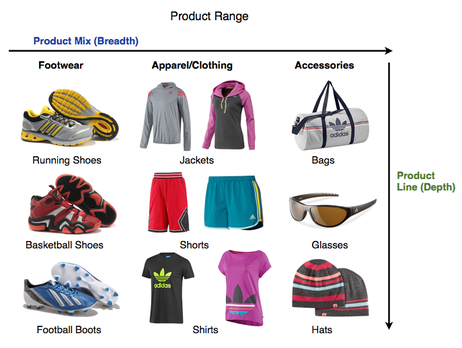
Source - keishelleeadidas
Adidas' product lines include a range of t-shirts, hoodies, shorts, sporting equipment, etc apart from shoes. Their apparel includes sweaters, shorts, tracksuits, jackets, swimsuits, sports bras, hoodies, and other items.
To produce such products with good quality in a scalable manner, Adidas collaborates with many researchers, creators, designers, and open source innovations to shape its sporting goods. For example, Adidas partnered with Parley for the Ocean to use the plastic waste from oceans and beaches for manufacturing shoes.
You can learn more about the innovation and watch documentaries - Adidas X Parley shoes
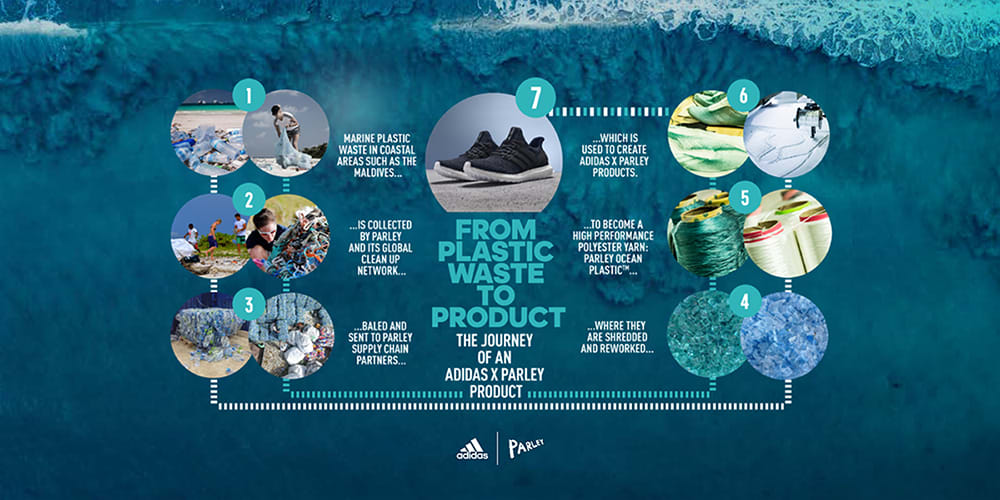
Overall, the brand's product portfolio is well-rounded, offering outstanding options in many vital areas.
To compete with Nike which had started to sell sporting equipment, Adidas too released its collection of backpacks, sunglasses, goggles, and watches to capture the market. This includes training equipment and yoga accessories too.
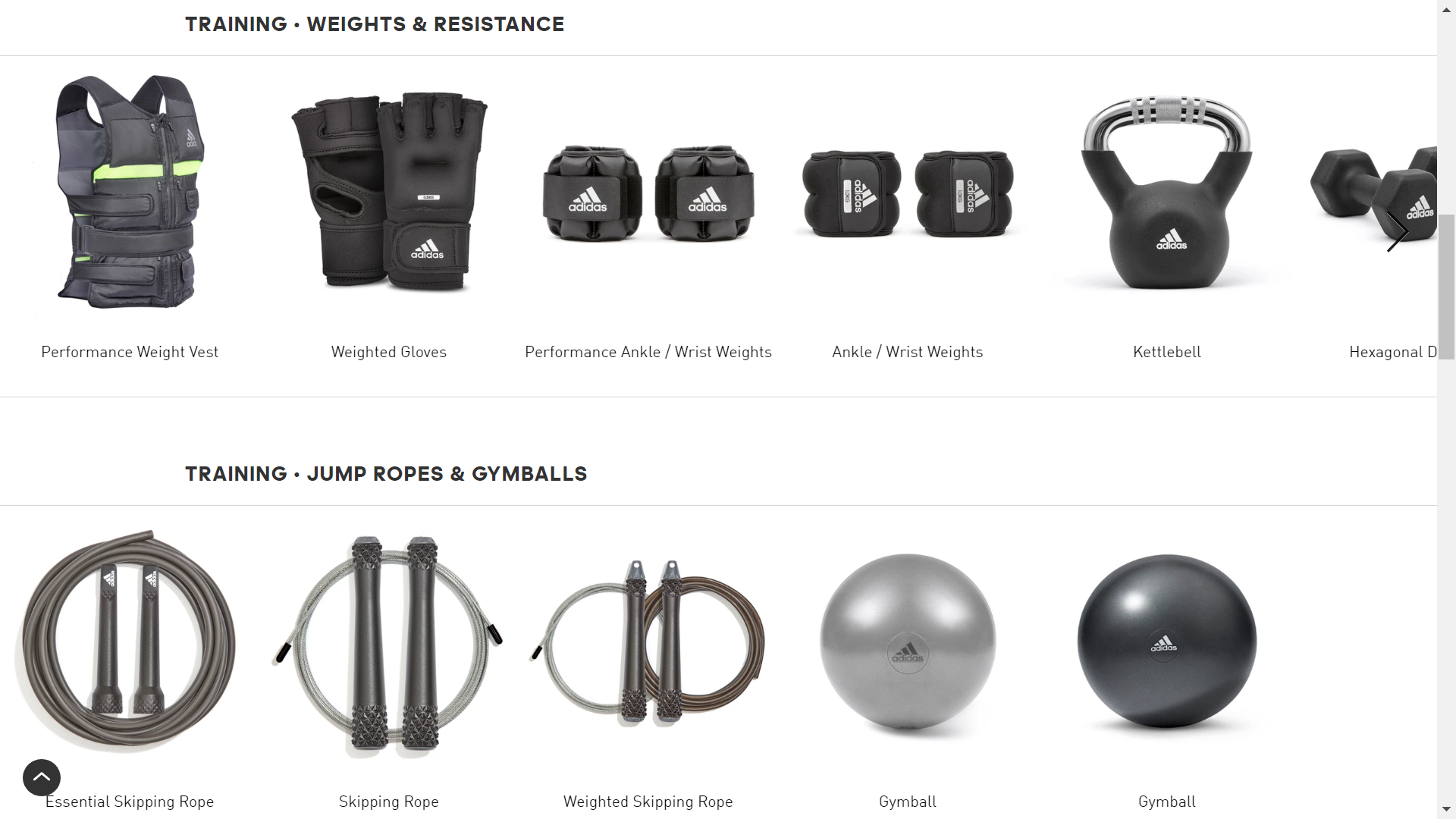
Source - Adidas Hardware
As mentioned, the Adidas marketing strategy also targets young audiences as a part of diversifying its product portfolio. It has a dedicated collection called Adidas Neo that sells casual footwear for young adults and children.
Adidas, even though has premium pricing, indeed keeps in mind its major competition across Puma, Nike, and other upcoming startups to price its products. It also follows the skimming pricing strategy, where newly launched products are kept at premium prices, and their value drops as they get out of fashion.
The Adidas brand spends a ton of money on traditional advertising methods. This includes billboards, TV, newspapers, magazines, etc. To compete with Nike, one of its strategic growth areas is to leverage digital marketing with social media, influencer marketing, and paid ad spending.
Adidas is also very actively involved in sponsoring sports teams, which includes big names like Real Madrid, England, South Africa cricket teams, United Kingdom Football, etc. Many professional athletes also form a part of its influencer campaigns.
Distribution Strategy
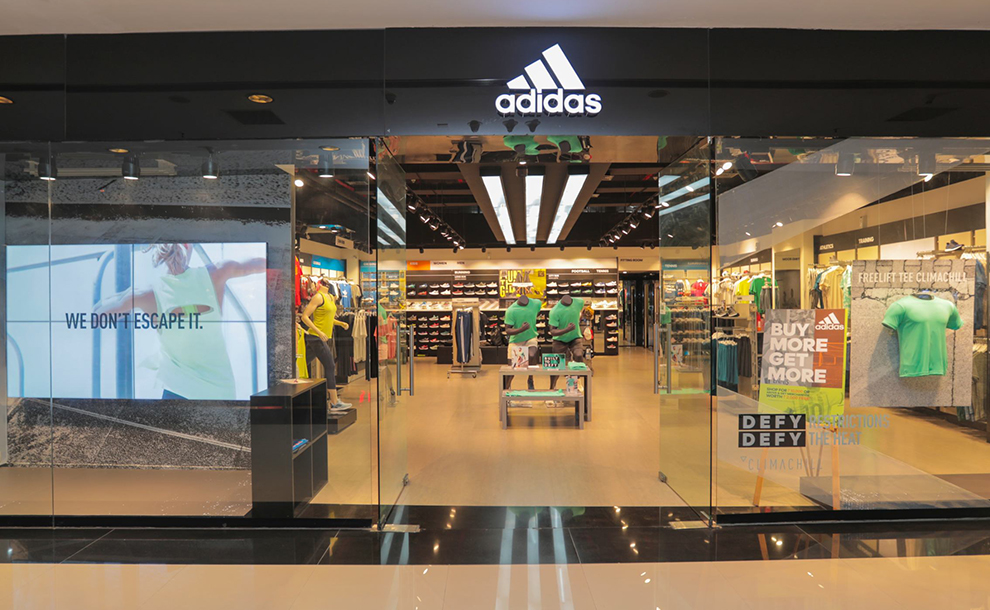
Source - Infinity Mall
Adidas, with its high speed manufacturing prowess and production process, has more than 500 independent factories across 55 countries. All its products are available in its own retail stores in malls, independent showrooms, other mega marts like Walmart, online stores like Amazon/Myntra, and its own eCommerce store for direct purchases.
The two sportswear giants' competition - Adidas vs Nike
Adidas and its main competitor Nike have nurtured their own sports fans in a fierce competition ruled by marketing spending. Consumers are loyal and both products are in high demand, but looking at their marketing strategy, one can find many differences stemming from their business ideology and country of origin.
Adidas has focused on tennis and soccer players, while Nike has focused on basketball and runners as its target audience. Within their segments, both have diversified to make sporting goods and equipment to cater to all their needs.
Their country of origin also plays an important role in how these brands market themselves. Being a U.S-based Brand, Nike focuses on its domestic market and many of its products are suited to American taste.
While Adidas, which is a German brand, has designed its products more suited to European feet and weather conditions. Its speedy manufacturing processes and production processes are enabled by German technology. Their German branding which is known for product excellence is indeed a unique selling point that gains potential consumers' trust across the world.
What makes Adidas' marketing strategy unique?
Building a company that lasts more than 70 years requires consistent branding efforts and adaptive business operations. Some key aspects of the Adidas marketing strategy that helps it stand out include:
Adidas digital marketing strategy

Source - SocialInsider
Adidas has its own eCommerce store is today one of its fastest growing revenue channel. For targeting the younger crowd which is more online, it's even more important today to maintain a strong digital marketing strategy. Its social media posts promote sustainability, action, inspiration, and a modern outlook.
To achieve this, Adidas itself went into digital transformation to become a digital company. Today, the company spends most of its marketing budget on digital campaigns and social media - as per MarketingWeek digital analysis of the brand.
Strategic Cities
Adidas makes its presence strong in certain cities of strategic importance and that are culturally influential. This includes prominent names like Paris, Tokyo, London, Shanghai, Los Angeles, and New York.
It is known that these cities influence fashion trends across the world. Many other strong competitor of Adidas also focus on these cities to ensure success there, post which they distribute the product worldwide. This forms a concentrated marketing strategy that helps reduce overall marketing efforts and budget if done right.

Memorable marketing campaigns by Adidas
Adidas' ads successfully create excitement and espouse inspiration to its viewers. They have worked with several professional athletes, musicians, actors, and influencers who align with its brand values. Some notable ad campaigns include:
Your future is not mine
This ad targets the younger generation, a customer segment that is of growing importance for the Adidas company. With futuristic visuals, the ad inspires one to take the future into your hands.
Muhammad Ali VS Laila Ali
The Impossible is Nothing campaign is a unique one, where they use technology to rework Muhammad Ali's images from his real-life matches to compete against his daughter, Laila Ali. This Adidas-created ad is a great use case of using AI for taking creative execution for ads to another world.
Partnership with Kanye West

Adidas partnered with Kanye West to release branded footwear - Adidas Yeezy and accessories that would appeal to his fans. Recently, due to Kanye's unfavorable behavior, the company cut ties on this deal, though it will continue to sell its shoes.
Key takeaways from Adidas marketing strategies
If you're working on building a retail business, there is a lot to learn from the Adidas marketing strategy and the founding story as well.
Here are some major takeaways:
Focus on building a quality supply chain
The Adidas company is successful today due to its strong focus on ensuring its product quality is at par with what its upper middle class and above target market find appealing. If you have good quality products, you can always sell, upsell and cross-sell across the world. Adidas ensures its products are also consistently available worldwide.
Don't neglect digital marketing
Adidas started to lose its market share with Nike due to its lackluster digital presence. Recently, it has vowed to regain its share by making digital as a key part of its overall marketing strategy. In today's age, one cannot neglect to be a digital company, especially post-pandemic.
Target the root cause of trend formation
Adidas smartly focuses on key cities that are responsible for fashion trends than doing any spray-and-pray approach to sell across the world. Adidas works to ensure the people of these cities use its products, while the rest gets taken care of via word of mouth.
Adidas is today's world's number 2 brand, just behind Nike. With its recent digital transformation, the Adidas digital marketing strategy would again create fierce competition in the sports retail market. If you enjoyed this case study, you can also get more retail-marketing insights from Nike's marketing strategy or beverage brands like Pepsi , Gatorade , and Monster Energy .
- popover#mouseOver mouseout->popover#mouseOut" data-popover-translate-x="-25%" , data-popover-translate-y="-220%"> Copy link
- bottom-bar#toggleTagsSection"> popover#mouseOver mouseout->popover#mouseOut" data-popover-translate-x="-25%" , data-popover-translate-y="-220%"> Copy Link
- bottom-bar#toggleTagsSection">

"Must read for every entrepreneur"

"The best part is it's written by real entrepreneurs"

"My favorite newsletter on the web"
You'll love these articles too!

Co-founder & CEO at Flexiple ($3mn+ revenue, bootstrapped) & buildd.co | Helping Startup...
Monster Energy Marketing Strategy: How Monster become a market leader by 'Unleashing the Beast'?
Learn about Monster's iconic marketing strategy and advertising campaigns. Read how Monster aces the 4Ps of marketing mix - Product, Price, Promotion & Placement.

Co-founder at Flexiple, buildd & Remote Tools ($3 million revenue, bootstrapped)
Breaking Down The Maruti Suzuki Marketing Strategy: How they became a brand that rules India's automobile market
Learn about Maruti Suzuki's iconic marketing strategy and advertising campaigns. Read how Maruti Suzuki's aces the 4Ps of marketing mix - Product, Price, Promotion & Placement.

Clinical Research | Data Analytics

Partner at Deloitte | Banking & Capital Markets | Cloud Strategy | FinOps Offering Leader | Board...

Swiggy Business Model: How the Company is Building a Brand That's Hard to Resist
Explore the innovative business strategies behind Swiggy's success, including the company's approach to building a strong brand and delivering unbeatable customer experiences. Learn how Swiggy is disrupting the food delivery industry and solidifying its place as a leader in the market.
Academia.edu no longer supports Internet Explorer.
To browse Academia.edu and the wider internet faster and more securely, please take a few seconds to upgrade your browser .
Enter the email address you signed up with and we'll email you a reset link.
- We're Hiring!
- Help Center

Branding and Customer Satisfaction: A Research about the Adidas Group


Related Papers
Malaysian Journal of Social Sciences and Humanities (MJSSH),
Isai Amutan Krishnan
Brand loyalty creates long term relationship between customer and brand. As a sportswear brand, to adopt a general customer loyalty to a brand, quality of the product and price are the crucial factors. The purpose of this research is to investigate how the respondents are influenced by factors of brand loyalty towards sportswear products. Previous research adopted seven factors to test in the Malaysian environment. The seven factors of brand loyalty are brand name, product quality, price, style, promotion, service quality and store environment. Brand name has shown strong correlation with brand loyalty. In order to increase customer satisfaction and attach them to be brand loyalists, marketers are encouraged to develop aggressive marketing programs. Questionnaires were distributed to 148 respondents. The research results have shown that there is positive and significant relationship between factors of brand loyalty (brand name, product quality, price, style, promotion, service quality and store environment) with certain sportswear brands. Others study on more focused factors that are appropriate to the Malaysian environment is recommended in order to obtain accurate information.
Management Science Letters
Ebrahim Zarepour Nasirabadi
Milenko Stanić
selda uca , Bilge Çavuşgil Köse
Customer satisfaction is an important factor for companies in order to exist and survive. It is considered that brand experience and brand name have important effects on knowledge and pleasure after the sale. This study aims to determine the relationship between brand experience (sensory-affective, behavioral, and intellectual dimensions) and brand name variables with customer satisfaction. In this context, a field study was conducted on 300 students registered at Trakya University, Faculty of Economics and Administrative Sciences (Department of Business Administration) and Social Sciences Institute (Department of Business Administration). In the selection of brand, individuals who have used the said brand were chosen as a prerequisite, and therefore, a leader fast-food restaurant brand which serves in Edirne was selected. As a result of this study, both brand experiences and brand name have positively affected customer satisfaction. According to the bivariate correlation analysis, a positive and medium strength relationship was revealed between dimensions of brand experience and brand name variables with customer satisfaction.
International Journal of Engineering and Management Research
SHAHRIAR IMRAN
IJRMS Journal
This study aims to investigate the effect of brand loyalty, brand association, brand awareness, and perceived quality on the brand equity and effect of the brand equity on the operational performance in Adidas products in Iran. The tool that were used in this research was questionnaire. In the first stage 418 questionnaires were distributed among students, then in the next step we could receive 395 questionnaires. Structural Equation Modeling (SEM) with Lisrel software was tested for the data analysis in this study. The results of this research suggest that there is a meaningful relationship and correlation between brand equity and operational performance. In fact, four variables including brand loyalty, brand association, brand awareness, and perceived quality has a direct effect on the brand equity and brand equity has a direct effect on operational performance.
Rahelia Margaretha
Ratiibu Ssemata
Today, brandisoneofthebasic elementsofthebusiness,an essentialand integral part ofthe marketing strategy in the world economy, brands marketing is placed in the heart of the business and mostly, it " s hiddenvalue resides within the hearts and minds of customers, clients, and prospects thatattracts them. Besides selling the products, establishing a lasting relationship between the product and certain group of customer " s is the main purpose of each organization, the extraction of this stable interaction brings about a kind of commitment and customer loyalty toward the product. Brands with unique identity and targets, by providing tangible and friendly feature, are able to make a rich and beneficial relationship with customer " s and not only capture a part of their heart and mind, but also capture a part of consumer " s daily life. Therefore, the present study has been performed to examine the impact of brand identity on the development of customer loyalty toward the brand in the industry of mobile phone brands. In the present research, brands of mobile phones such as Nokia, Sony, Samsung, Sony Ericsson, HTC and GLXhave been selected to study as the statistical population and sample of the research of 385 persons in the chief (metropolis) city of Rasht. This research has been a Descriptive and Causal study and has been made through Field method. The data resulted from the questionnaire, has been examined by applying statistical tests proportional to research hypotheses using Spss and Lisrel software. The research findings indicate that all hypotheses were confirmed but hypotheses of relationship between brand identity and perceived value, customer satisfaction and confidence in brand through its identification. INTRODUCTION Today brandis one of the most important subjects of the marketing that is in front of all companies such as commercial firms and they are calculated as company's valuable assets economically and strategically. Over the last few years, researchers have concluded that the real value of products and services is not inside of the company's products and services,butratherin the mind of real and potential customer " sand this is the brand that creates the real value in customer " s minds. The American Marketing Association (AMA) defines a brand as a "name, term, sign, symbol or design, or a combination of them intended to identify the goods and services of one seller or group of sellers and to differentiate them from those of other sellers.David also says that brand is a symbolwhich haslinked with a large number of assets and mental liabilities(Dehdashti Shahrokhet al.,2012). The main purpose of each organization is tocreate a steady relationship and connection between the product and a particular group of customer " s,as well as selling its product, the extraction andjuice of this lasting relationship is led to a kind of commitment and loyalty toward the product (Mir and Ghafari, 2010). The study of existing theoretical literature in the field of consumer behavior indicates that brand loyalty has been raised as an important and effective concept and describessignificant part of consumer " sbehavior at the time of choosing and purchasing (Saeednia and Jamali, 2010).
Nigerian Chapter of Arabian Journal of Business and Management Review
sadraddin sattari
RELATED PAPERS
The Lancet Psychiatry
Pia Zeinoun
Physical Review Letters
shannon watson
Jorge Bonassa
Abdulmutalib Raafat Sarhat
Sriwahyuni, Nur fadilah, Husnul khotibah, Nurul Istiqomah, Nuni idrianti
Nuni Idrianti
Marília Peres
arXiv (Cornell University)
Palle Jorgensen
Journal of Biomolecular Structure and Dynamics
iqra muneer
European Journal of Haematology
Simona Sestili
Biochemical and Biophysical Research Communications
Rudee Surarit
Gaceta Medica De Mexico
Jose Arturo Gayosso Rivera
Advances in Mathematics of Communications
Antonio Cossidente
Prof. Dr. Roland Kirstein
Inorganica Chimica Acta - INORG CHIM ACTA
Stephen Gayda
Boletin de la Sociedad Argentina de Botanica
alvaro martin gallego vega
Garret Romaine
Medecine Et Maladies Infectieuses
jorgelina orfila
Center Of Education Journal (CEJou)
Nabila Khoirunnisa
BMC Health Services Research
Astrid Blystad
Christianity in Modern China
Raissa De Gruttola
- We're Hiring!
- Help Center
- Find new research papers in:
- Health Sciences
- Earth Sciences
- Cognitive Science
- Mathematics
- Computer Science
- Academia ©2024
- All agencies in USA
- Los Angeles
- San Francisco
- Philadelphia
- All services in USA
- AI Marketing
- Digital Marketing
- Social Media Marketing
- Email Marketing
- Content Marketing
- All industries in USA
- Travel & Tourism
- Real Estate
- Fashion & Retail
- Media & Entertainment
- Food & Beverage
- Agency of the Month

- All agencies in the UK
- Bournemouth
- All services in the UK
- All industries in the UK

- All agencies in Canada
- All services in Canada
- Influencer Marketing
- All industries in Canada
- Travel Tourism
- All agencies in Australia
- All services in Australia
- PPC Marketing
- All industries in Australia
- Beauty & Cosmetics
- Hospitality

- All agencies in Europe
- All services in Europe
- Web Development
- All industries in Europe
- IT & Technology

- All agencies in Asia
- All services in Asia
- B2B Marketing
- All industries in Asia

- Agency News
- Marketing Resources
- Industry News

- Digital Ad Campaigns
- Case Studies
- Social Media Campaigns

- Marketing Blog
- Advertising
- Ecommerce Marketing

- Industrial Blog
- Fashion Marketing
- Sports Marketing
- Luxury Marketing
- Legal Marketing
- Healthcare Marketing

- Digital Marketing Tools
- Marketing Reporting Tools
- Digital Marketing Analytics Tools
- Email Marketing Tools
- Other Tools
- Social Media Management Tools
- Social Media Marketing Tools
- Social Media Analytics Tools
- Social Media Monitoring Tools
- Influencer Marketing Platforms
- Web Design Tools
- Landing Page Builders
- UI / UX Design Tools
- Website Builder Software
- Front End Development Tools
- Team Management Softw...
- Project Management Tools
- Agency Management Software
- Productivity Management Software
- Time Tracking Tools
- Sales Tools
- Sales Automation Tools
- Product Feed Management Tools
- Sales Enablement Tools
- AI Design Tools
- AI Content Tools
- AI Analytics Tools
- AI Marketing Tools
- Performance & Software
- Website Optimization Tools
- Content Delivery Network Tools
- Cybersecurity Software
- Web Accessibility Tools
Market your SaaS Tools and reach digital agencies & marketing professionals worldwide.
- All Categories in USA
- Artificial Intelligence Events
- Design & Development Events
- Digital Marketing Conferences
- Social Media Events

UK Content Awards 2024

Ecommerce Forum 2024
Submit your exclusive marketing event today.
Submit your event to reach a wider audience! Whether it's digital marketing, AI, or any related theme, we would love to help spread the word out!
- All Categories in UK
- All Categories in Canada
- All Categories in Australia
- All Categories in Europe
- All Categories in Asia

Top Things You Should Know About Adidas’ Digital Marketing Strategy & Campaigns
The digital marketing strategy and campaigns are behind much of the success of the number one sportswear manufacturer in Europe that it has enjoyed in recent years. Adidas focuses on leveraging the power of digital channels to create engaging and personalized experiences for its customers.
Changing consumer behaviors with the digital transformation leading people to make more online purchases also changes what Adidas focuses on. For instance, Adidas is investing more than €1 billion in digitalization, including digital marketing, as part of its main growth strategy until 2025, “Own the Game.”
Digital Marketing Strategies of Adidas
Adidas focuses heavily on digital marketing, dedicating a significant portion of its budget to campaigns that span platforms like YouTube and social media. The brand aims to engage with its audience and create personal connections, using data-driven insights to be where its customers are online.
Let’s look at Adidas’ digital marketing strategies one by one:
Digitalization
The company spends the biggest part of its marketing budget on digital campaigns. Describing itself as a digital company, Adidas wants to be the world’s best sporting apparel brand. For the “best” means designing, building, and selling the most unique and comfortable sports goods in the world. In order to achieve this, they use digitalization as the key part of their marketing strategy to inform their target audience about their products. From commercials published on YouTube to engaging social media posts, Adidas utilizes various digital marketing channels to spread the word.
Relationship with Customers
Adidas tries to interact with its customers and create personalized experiences. In other words, Adidas generates enthusiasm and excitement about sports on a personal level. The brand takes every touchpoint like mobile, social, and retail to interact with the consumers to provide an inspiring and personal experience. By taking insights from digital analysis, Adidas tries to be everywhere its consumers are.
Engine Digital collaborated with the Adidas Digital Future Team to meet the needs of Run Genie’s audience. The agency was tasked with defining an end-to-end customer experience that enables the sales team to guide the purchase decision through data visualization and connected hardware.
Here you can learn more about the project: Adidas: Using Data to Choose the Perfect Shoe

Open-Source Innovations and Collaborations
Adidas opens its doors and calls everyone including athletes, consumers, and partners to shape the future of sports and sports culture. They focus on bringing unique and useful products to the market altogether to meet the demands of today’s world and the common future. A great example of such creative collaborations is Adidas’s partnership with Parley for the Oceans producing three new UltraBoost models from ocean plastic waste.
Strategic Cities
Six cities (London, Los Angeles, New York, Paris, Shanghai, and Tokyo) that shape the consumers’ perceptions, trends, and buying decisions have strategic importance in Adidas’s marketing strategy. Adidas spends more to market its products in these countries but it differentiates the products to be advertised for each country regarding the culture and the demands of the markets. For example, in Europe, they focus on selling soccer products, but the US is a key country for other subsidiaries like basketball and baseball.

The company is constantly revisiting its portfolio with a focus on the core brands: Adidas and Reebok. For instance, in 2018, Adidas repositioned Reebok for more profitability. For Reebok, they collaborate with influential women designers like Victoria Beckham and women who want to change the world like Ariana Grande and Gigi Hadid to make the brand more appealing to women.
Top Marketing Campaigns of Adidas
Adidas’ marketing campaigns and advertisements have always had an impact on the younger generations. To have a more comprehensive understanding of Adidas’ marketing strategy, let’s see the most memorable Adidas marketing campaigns:
Impossible Is Nothing
Adidas has been using this motto since 2004 to highlight “ the attitude Adidas shares with athletes around the world – the desire to push yourself further, to surpass limits, to break new ground.”
In 2022, the “Impossible is nothing” motto started to evolve into something bigger and more inclusive. This time, Adidas’ “Impossible is nothing” campaign features female athletes to call all women to action who “ keep making the impossible possible every day .”
With this campaign telling female athletes’ stories who are making their own paths to success despite the gender apartheid, Adidas demonstrates that it can keep up with changing world of new generations demanding equality.
Take the Deal, Dare to Create
Launched in 2019, this campaign aims to push the boundaries of creativity and inspire people to make bold statements through their style and create their own paths. The “Take the deal, dare to create” campaign features a diverse group of athletes from different cultures who dare to challenge the norm and create their own style.
The message given with this campaign is that by taking the deal and being bold, you can create something one of a kind. Adidas implies that its sportswear is the product of creativity with the highest level of uniqueness and it is always ready to accompany you in your journey to find your true self and express it through what you wear.
#When Football Is Everything, Impossible Is Nothing
Adidas fuelled the FIFA World Cup 2022 excitement with a new version of its classic motto, “When football is everything, impossible is nothing.”
In this commercial, Adidas becomes a symbol of reunion and warm feelings. As Lucio Dalla Gasperinathe, the Director of Global Brand Communications of Adidas states that the focus on a family reunion in this campaign demonstrates that everyone gets together for the love of football; even the superstars reunite for such precious events. So, Adidas invokes a feeling of nostalgia in the audience and benefits from the power of digital to associate itself with the good old days.
Inspiring Social Media Campaigns of Adidas
From empowering female athletes to embracing augmented reality, Adidas isn’t just selling sneakers; it’s sparking movements. Get ready to witness a brand that constantly pushes boundaries, celebrates diversity, and proves that on social media, ‘impossible’ is just another hashtag.
Here are some of the best Adidas campaigns that create buzz on social media:
#She Breaks Barriers
In a world where sports media silence echoes for female athletes, Adidas steps up with “She Breaks Barriers.” This campaign amplifies, empowers, and fuels. It tells the stories of champions like Biles and Vonn, inspiring a generation to shatter glass ceilings. Educational programs break down biases, paving the way for equal media and opportunities.
Support, choose, and advocate are what the brand suggests with this social media campaign, leading the audience to rewrite the narrative of achievement, where women in sports not only conquer but redefine.
#RunForTheOceans
Partnering with Parley for the Oceans, Adidas proves that sneakers aren’t just for the streets; they’re for saving the seas, one stride at a time. So, go on, chase those endorphins and the tide against plastic pollution.
Bu gönderiyi Instagram'da gör 이연진 (@yeounjin2664)'in paylaştığı bir gönderi
Every mile you conquer cleans a mile of plastic off our precious blues. Join the #RunForTheOceans movement and watch your run become a ripple of change.
Bu gönderiyi Instagram'da gör Dave (@schneckenschaefer_lauf)'in paylaştığı bir gönderi
#ImpossibleIsNothing
Remember the kid who dreamed of backflips in the backyard? #ImpossibleIsNothing is that dream taking flight, fueled by cheers from a community as passionate as your goals.
Micro-challenges, everyday heroes, and creators pushing boundaries redefine “impossible” one scroll at a time. It’s a movement about defying limits, not chasing views, lifting each other up as we conquer personal peaks.
The #ImpossibleIsNothing campaign, featuring Candace Parker, achieved remarkable reach on TikTok, with over 57 million impressions. This success was further amplified by near-perfect brand safety and suitability scores, ensuring viewers encountered the campaign within highly trustworthy content environments.

Adidas’ campaigns play an important role in the brand’s digitalization process. It effectively utilizes various channels, like its captivating social media campaigns, to forge connections with its target audience and increase brand awareness. Adidas’ digital marketing strategy is developed to boost its growth, as it is not content with being the number one sportswear brand in Europe. It uses digital mediums to beat its biggest competitor, Nike, in this game. If you are curious about what kind of campaigns Nike has been running, you can check out our blog post about Nike’s marketing strategy . And if you are looking for professionals to get ahead of your competitors, you can discover top sports marketing agencies and take action!
Share this post

Related Posts

Subscribe to keep up with fresh news and exciting updates. We promise not to spam you!
This website uses cookies. Continued use of this website indicates that you have read and agree to our Terms & Conditions and Privacy Policy .
📕 Studying HQ
Adidas analysis: a comprehensive guide for business students, dr. wilson mn.
- June 14, 2023
- Business Analysis Examples
If you are a business student who wants to know what made Adidas so successful, this detailed guide is for you. In this article, Adidas Analysis, we’ll talk in-depth about Adidas’s history, vision, mission, products and services, position in its industry and on the market, and key competitors.
Adidas is a multinational company that designs and makes products for sports and everyday life, like shoes, clothes, and accessories. Adolf Dassler started the company in 1949, and it has since become one of the most popular sportswear brands in the world. Business students who want to study the sportswear market and learn from Adidas’ marketing strategies need to know what made Adidas so successful.
What You'll Learn
Company Profile
Company history.
Adidas was founded in 1949 by Adolf Dassler, who had previously co-founded the sportswear company Puma with his brother. The company’s early focus was on designing and manufacturing athletic footwear, and it quickly gained a reputation for its high-quality products. In the 1960s, Adidas expanded its product line to include apparel and accessories, and by the 1980s it had become a global brand with a strong presence in the sportswear industry.
Vision, Mission, and Core Values
Adidas’ vision is to be the best sports company in the world . Its mission is to design and manufacture products that help athletes of all levels achieve their full potential. The company’s core values include performance, passion, integrity, and diversity.
Products and Services
Adidas offers a wide range of products and services, including footwear, apparel, and accessories for sports and lifestyle activities. Its product lines include Adidas Originals, Adidas Golf, and Adidas Running, among others. The company also offers customization services, allowing customers to personalize their products with their own designs and logos.
Industry and Market Position
Adidas operates in the highly competitive sportswear industry, which includes companies such as Nike, Under Armour, and Puma. In recent years, Adidas has gained market share and increased its revenue, driven by strong growth in its North American and Asian markets. The company has also made strategic investments in e-commerce and digital marketing, which have helped it stay competitive in the fast-changing retail landscape.
Key Competitors
Adidas’ key competitors in the sportswear industry include Nike, Under Armour, and Puma. Nike, in particular, is Adidas’ main rival, with a similar focus on innovation, marketing, and brand building. Under Armour and Puma are also significant competitors, with a focus on performance and lifestyle products, respectively.
SWOT Analysis on Adidas
SWOT analysis is a valuable tool for analyzing a company’s strengths, weaknesses, opportunities, and threats. Here is a SWOT analysis on Adidas:
1. Strong brand recognition: Adidas is one of the most recognized sportswear brands in the world, with a long history of high-quality products and innovative marketing strategies .
2. Diversified product portfolio: Adidas offers a wide range of products and services, including footwear, apparel, and accessories for sports and lifestyle activities, as well as customization services .
3. Strong presence in key markets: Adidas has a strong presence in the North American and Asian markets, which have been key drivers of its revenue growth in recent years.
4. Focus on sustainability : Adidas has made sustainability a key part of its business strategy , with a focus on reducing its environmental impact and promoting social responsibility.
1. Dependence on key product lines: Adidas’ revenue is heavily dependent on its footwear and apparel product lines, which make up a large majority of its sales.
2. Limited market share in certain regions: Adidas has a relatively low market share in some regions, such as Latin America and the Middle East, which could limit its growth potential.
3. Vulnerability to economic downturns: Like other companies in the retail industry, Adidas is vulnerable to economic downturns and fluctuations in consumer spending.
Opportunities
1. Growth in e-commerce: Adidas has made strategic investments in e-commerce and digital marketing, which could help it reach new customers and expand its market share.
2. Expansion into new markets: Adidas has an opportunity to expand into new markets, such as emerging economies in Asia and Africa.
3. Innovation and product development: Adidas has a strong focus on innovation, and has the potential to develop new products and technologies that could drive growth and increase its market share .
1. Intense competition: Adidas faces intense competition in the sportswear industry, particularly from Nike, its main rival.
2. Fluctuations in currency exchange rates: As a global company, Adidas is vulnerable to fluctuations in currency exchange rates, which could affect its revenue and profitability.
3. Changing consumer preferences: Consumer preferences and trends can change quickly, and Adidas needs to stay ahead of these changes to remain competitive.
Adidas has a strong brand recognition, diversified product portfolio, and a focus on sustainability, which are key strengths that differentiate it from its competitors. However, the company also faces weaknesses , such as its dependence on key product lines and limited market share in certain regions. By focusing on opportunities such as growth in e-commerce, expansion into new markets, and innovation, and by mitigating threats such as intense competition and fluctuations in currency exchange rates, Adidas can continue to grow and succeed in the highly competitive sportswear industry.
Noteworthy Research Papers on Adidas
Here are some noteworthy research papers on Adidas:
1. “ The Impact of Digital Marketing on Consumer Behavior in the Sportswear Industry: A Case Study of Adidas ” by Emma Chen and James Williams. This research paper examines the impact of digital marketing on consumer behavior in the sportswear industry, using Adidas as a case study. It explores the effectiveness of Adidas’ digital marketing strategies and their impact on consumer engagement and purchasing behavior.
2. “ Corporate Social Responsibility in the Sportswear Industry: An Analysis of Adidas’ Sustainability Strategy ” by Maria Garcia and John Smith. This research paper analyzes Adidas’ sustainability strategy and its impact on the company’s corporate social responsibility efforts. It examines the company’s initiatives to reduce its environmental impact, promote social responsibility, and engage with stakeholders.
3. “ Brand Equity and Financial Performance: An Analysis of Adidas’ Marketing Strategy ” by Sarah Lee and David Anderson. This research paper analyzes Adidas’ marketing strategy and its impact on the company’s brand equity and financial performance. It examines the company’s approach to brand building, including its use of celebrity endorsements, social media , and sponsorships, and their impact on consumer perceptions and financial metrics.
4. “ Innovation and Competitive Advantage in the Sportswear Industry: A Case Study of Adidas’ Product Development Strategy ” by Robert Johnson and Emily Davis. This research paper analyzes Adidas’ product development strategy and its impact on the company’s competitive advantage in the sportswear industry. It examines the company’s approach to innovation, including its use of technology, materials, and design, and their impact on product differentiation and consumer demand.
These research papers provide valuable insights into Adidas’ business strategies , organizational culture, and impact on the sportswear industry. They use a variety of research methodologies, including case studies , surveys, and interviews, to collect data and analyze the findings.
Essay Titles on Adidas
Here are some captivating essay titles related to Adidas:
1. “Adidas vs. Nike: A Comparative Analysis of Marketing Strategies and Brand Equity
2. Corporate Social Responsibility in the Sportswear Industry: A Case Study of Adidas
3. The Impact of Digital Marketing on Consumer Behavior: A Study of Adidas’ Marketing Strategy
4. Innovation and Competitive Advantage in the Sportswear Industry: An Analysis of Adidas’ Product Development Strategy”
5. The Role of Sustainability in Adidas’ Business Strategy and Organizational Culture”
6. The Effects of Celebrity Endorsements on Consumer Perception: A Case Study of Adidas
7. Adidas’ Expansion into Emerging Markets: Opportunities and Challenges
8. The Impact of COVID-19 on Adidas’ Operations and Financial Performance
9. “Sportswear Industry Trends and Adidas’ Strategic Response”
10. The Importance of Intellectual Property Rights in the Sportswear Industry: A Case Study of Adidas
Research Topics on Adidas
Here are some potential research topics related to Adidas:
1. The impact of Adidas’ brand image and reputation on consumer behavior
2. A comparative analysis of Adidas’ and Nike’s supply chain management strategies
3. The role of innovation in Adidas’ product development and competitive advantage
4. The effectiveness of Adidas’ digital marketing strategies in engaging consumers
5. An analysis of Adidas’ sponsorship and endorsement deals with athletes and teams
6. The importance of corporate social responsibility in Adidas’ business strategy and organizational culture
7. The impact of sustainability initiatives on Adidas’ financial performance
8. An evaluation of Adidas’ expansion into emerging markets and its impact on the company’s growth
9. An assessment of Adidas’ intellectual property rights management and protection strategies
10. The effects of COVID-19 on Adidas’ operations and supply chain management
Frequently Asked Questions on Adidas
Here are some common questions and answers about Adidas:
1. What is Adidas known for?
Answer: Adidas is known for designing and manufacturing athletic and lifestyle products, including footwear, apparel, and accessories for sports and lifestyle activities.
2. When was Adidas founded?
Answer: Adidas was founded in 1949 by Adolf Dassler.
3. What is Adidas’ mission statement?
Answer: Adidas’ mission is to design and manufacture products that help athletes of all levels achieve their full potential.
4. Who are Adidas’ main competitors?
Answer: Adidas’ main competitors in the sportswear industry include Nike, Under Armour, and Puma.
5. Does Adidas focus on sustainability?
Answer: Yes, Adidas has made sustainability a key part of its business strategy, with a focus on reducing its environmental impact and promoting social responsibility.
6. Where is Adidas based?
Answer: Adidas is based in Herzogenaurach, Germany.
In conclusion, Adidas is a leading sportswear brand with a strong presence in the global market . Understanding the factors behind its success , such as its diversified product portfolio, strong presence in key markets, and focus on sustainability, is crucial for business students who want to analyze the sportswear industry and learn from Adidas’ marketing strategies. By conducting a SWOT analysis and exploring research topics related to Adidas, students can gain a deeper understanding of the company’s business strategies, organizational culture, and impact on the sportswear industry.
Further Reading
Here are some recommended books, articles, and case studies on Adidas:
1. “ Adidas: The Story of the World’s Best-Selling Sneaker ” by Barbara Smit
2. “ Sneaker Wars: The Enemy Brothers Who Founded Adidas and Puma and the Family Feud That Forever Changed the Business of Sports ” by Barbara Smit
3. “ Adidas: The Sustainable Business Model ” by Steffen Knoth and Oliver Salzmann
4. “The Adidas Group: Sustainability and Innovation in Sportswear” by Andrew Spicer and Martin Perry
5. “ Marketing Strategies of Nike and Adidas: A Comparative Study ” by Dr. D. Suganya and Dr. R. S. Suresh
Start by filling this short order form order.studyinghq.com
And then follow the progressive flow.
Having an issue, chat with us here
Cathy, CS.
New Concept ? Let a subject expert write your paper for You
Have a subject expert write for you now, have a subject expert finish your paper for you, edit my paper for me, have an expert write your dissertation's chapter, popular topics.
Business Analysis Examples Essay Topics and Ideas How to Guides Nursing
- Nursing Solutions
- Study Guides
- Free College Essay Examples
- Privacy Policy
- Writing Service
- Discounts / Offers
Study Hub:
- Studying Blog
- Topic Ideas
- How to Guides
- Business Studying
- Nursing Studying
- Literature and English Studying
Writing Tools
- Citation Generator
- Topic Generator
- Paraphrasing Tool
- Conclusion Maker
- Research Title Generator
- Thesis Statement Generator
- Summarizing Tool
- Terms and Conditions
- Confidentiality Policy
- Cookies Policy
- Refund and Revision Policy
Our samples and other types of content are meant for research and reference purposes only. We are strongly against plagiarism and academic dishonesty.
Contact Us:
📞 +15512677917
2012-2024 © studyinghq.com. All rights reserved

How Is Adidas Different From Its Competitors | Adidas Marketing Strategy

Pratyusha Srivastava , Akshat Hawelia
Adidas, the second-largest sportswear manufacturer in the world, is a German Multinational corporation founded by Adoft Dassler. Adidas is mainly a sportswear manufacturer with the categories of clothing, shoes, and other accessories.
Looking at the beginning of Adidas was started in a house owned by Adolf's mother in 1924. Later, Adolf's elder brother, Rudolf, also joined him, and they named it " Gebrüder Dassler Schuhfabrik, " which simply means Dassler Brothers Shoe Factory.
A few years later, because of some major conflict between the brothers, the company split, and Adolf created Adidas, while his brother created the biggest rival of Adidas- Puma. Sounds interesting, right?
Adidas is widely known as the largest sportswear manufacturer in Europe, but on a global basis, it is beaten by Nike. Headquartered in Herzogenaurach, Germany, Adidas has its chairman, Thomas Rabe, and its current CEO, Bjørn Gulden. The brand manufactures the product category of footwear, sportswear, Apparel, equipment, and toiletries.
We all have heard a lot of things about Adidas, but the marketing strategies of the brand are known by very few. Adidas is brilliant when it comes to marketing, and no doubt, the company has established one of the strongest positions in the global market. Moving forward, let's get started with Adidas' marketing strategies.
Marketing strategy of Adidas
Seo strategy of adidas, social media strategy, email marketing, adidas strategy of limited supply, meme marketing, sponsoring sports events and athletes, influencer marketing, customer loyalty and engagement, strategically targeting cities.
Key takeaways from Adidas Marketing Strategy STP (Segmentation, Targeting, and Positioning) of Adidas Major Marketing Campaigns of Adidas Covid-19 Marketing Strategy
Adidas's marketing strategy is what makes it the best of all. Adidas is known to have the strongest establishment in the global sportswear manufacturing market, other than its American rival, Nike.
We have briefly discussed all the aspects of Adidas' marketing strategy, which are mentioned below. Adidas has built up great competition for the companies in the market, leaving them with the only choice to stand out of the race. Adidas' target markets are athletes and the 20 to 30 age group while also fostering connections with the 13 to 18 age range, acknowledging them as the future generation of prominent athletes. This dual approach ensures a comprehensive engagement with current and upcoming sports enthusiasts. Adidas USP is its comfortable and lightweight sportswear, as well as its innovative technology and design.
4Ps of Marketing of Adidas
Product: Adidas, renowned for its athletic footwear, is the second-largest sports shoe brand globally. Notable shoe models include the Adidas Superstar , acclaimed for its basketball performance and casual appeal. The Adidas Stan Smith is a minimalist and functional choice for tennis players. The Adidas Samba , originally for soccer, became a stylish option. The Adidas Ultra Boost series is lauded as an ideal running shoe for exceptional comfort and energy return. Beyond footwear, Adidas offers a comprehensive range of sportswear accessories and has even ventured into perfumes and sports equipment.
Price: Adidas employs competitive pricing for regular products, considering rivals like Nike and skimming pricing for cutting-edge items. Targeting high-end consumers, Adidas justifies premium prices with superior quality, reinforcing a perception of exclusivity. However, this pricing strategy makes Adidas products less accessible to the general public, leading to the prevalence of cheap imitations in some markets. While this elitist image enhances the brand's appeal to its target clientele, it also turns Adidas into a status symbol rather than just a preference for quality.
Place: Adidas implements a comprehensive place strategy with 198 stores in the U.S., excluding New Mexico, and over 1990 concept stores globally. California leads with 34 outlets. The brand leverages online platforms like Amazon , Flipkart , Myntra , and its official website, offering personalized merchandise options for global accessibility.
Promotion: Adidas achieved its household name through strategic and extensive marketing efforts. The brand invests heavily in traditional billboards, TV, magazines, and social media advertising. Notably, Adidas collaborates with influential celebrities such as Kanye West, Beyonce, Lionel Messi, and Stella McCartney for endorsements, inking million-dollar contracts. Additionally, Adidas has built a notable reputation by sponsoring football teams like Germany, Mexico, Spain, and Argentina.
Before we get started with Adidas's key marketing strategies, let us brief you about its brand portfolio, which includes Reebok, Rockport, Adidas, and Taylor. The main reason for such distribution is to target different segments of the audience more efficiently.
Adidas follows a very straightforward and encompassing approach towards the implementation of SEO . The head of global SEO and social media manager of Adidas, Mattia Santin, said in an interview that the Adidas SEO team focuses more on flexibility , especially when it comes to analytical, alongside various white-hat SEO principles.
The team mainly focuses on data and targeting personas that help guarantee the expected results and ensure that the changes are profitable.

When it comes to social media, Adidas and groups are pretty active, especially on Facebook and YouTube channels. On these platforms, the brand posts promotional videos of its latest products and services.
Apart from this, the brand has various active accounts on Twitter as well, such as Adidas Football, Adidas Original, and Adidas US. Through these, the brand connects with its fans and followers more efficiently. Adidas works on building strong energy in the audience towards Sports and athletes.
Adidas uses the technology of ECS for the email marketing program , which started in October 2020. They segment their audience, send dynamic product recommendations, and use stunning visuals and inspiring stories to capture attention. Exclusive offers, automated emails, and mobile-optimized design keep customers engaged, while social media integration and performance measurement ensure continuous improvement.
By focusing on these key elements, Adidas has built a robust email marketing program that drives engagement, sales, and brand loyalty, solidifying its status as a sportswear giant.
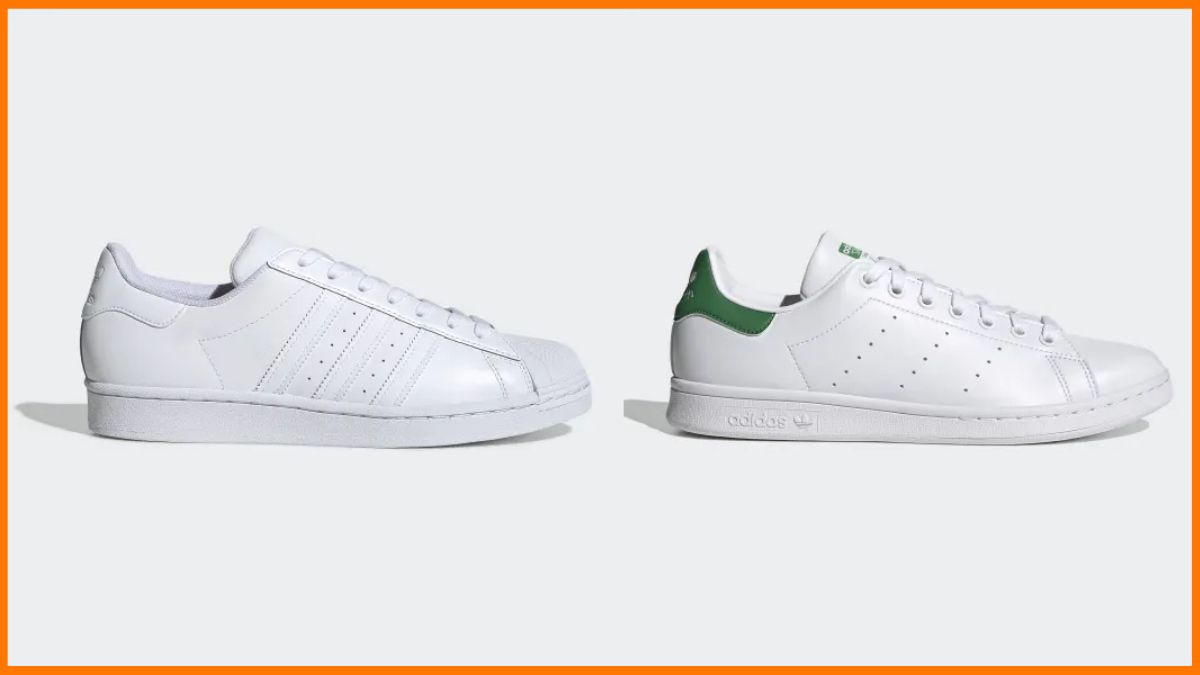
One of Adidas' most incredible marketing strategies is a limited supply. Basically, the brand limits the availability of its most famous shoes, like Stan Smith and Superstar , in order to increase the demand among the audience. This benefits the brand with great numbers and prices.
We all know that when there is a limited supply, its price automatically goes up, and Adidas masters this economic rule. This also helps Adidas' competitive advantage in merchandise margins, which has grown significantly.
Adidas is not behind in meme marketing as well. In fact, the brand has developed its very own riff on the famous "Thug Life" meme. This has become a social-driven campaign for Adidas.
Adidas leaves nothing when it comes to charming football fans, and with its incredible campaigns and meme ideas , the brand always proves its superiority.
Adidas has been known to create one of the most viral memes of the moment for showing off the Ace PureControl football boots, which are absolutely laceless.

Adidas has successfully partnered with renowned sports organizations and athletes globally. Aligning with prestigious entities like the NBA, MLS, FIFA, and the Olympic Games, Adidas secures long-term contracts and exclusive product lines, enhancing brand visibility and broadening its appeal. Noteworthy collaborations include being the official kit supplier for elite soccer teams like Manchester United, Real Madrid, and Bayern Munich. Adidas also sponsors individual athletes, including Lionel Messi , James Harden, and Naomi Osaka, leveraging these alliances to extend its reach by tapping into the vast fan bases associated with these athletes and organizations.

Adidas places a strong emphasis on influencer marketing , making substantial investments in collaborations with notable figures. The brand strategically partners with celebrities like Kanye West, Pharrell Williams, and Beyonce, creating exclusive product lines that resonate with their extensive fan base. Adidas collaborates with renowned personalities such as Kendall Jenner , David Beckham , and Karlie Kloss for impactful campaigns targeting their followers. The brand extends its reach further by collaborating with popular Instagram influencers, including @sneakerprophet_ and @yankeekicks, to showcase and generate excitement around the latest Adidas products. This robust influencer strategy is pivotal in promoting Adidas and enhancing its brand visibility.
Adidas places a significant focus on fostering customer engagement and loyalty by utilizing social media as a platform for connection. The brand actively participates in customer relationship-building through its loyalty program, named "Creators Club," which rewards customers for both their purchases and interaction with the brand. This program provides exclusive benefits such as early access to new products, special discounts, and personalized content. Furthermore, Adidas maintains customer engagement through social media-driven contests, encouraging customers to share content featuring Adidas products for a chance to win prizes.
Adidas' marketing strategies aim to establish meaningful connections with customers, enhance brand awareness and loyalty, and ultimately drive sales. Through strategic approaches like partnerships, influencer collaborations, innovative product design, digital marketing, and interactive customer engagement, Adidas has successfully solidified its position as a leading brand in the sportswear industry.
Adidas strategically centers its marketing efforts on six key cities—Los Angeles, London, Paris, New York , Tokyo, and Shanghai. By honing in on these urban hubs, Adidas gains valuable insights into diverse trends, enabling the brand to meet the specific needs of consumers in different locations effectively. For instance, in Europe, the emphasis lies on marketing football-related products, whereas in the United States, the focus extends to affiliations with baseball and basketball. Notably, North America commands the largest share, constituting 40 percent of the sporting goods industry, reinforcing Adidas' significant presence and impact in this market.
Key Takeaway from Adidas Marketing Strategy
With its incredible marketing strategies, the company results in great numbers and sales. The most distinctive strategy that Adidas opts for is user & user-user-benefits-based positioning, forming Adidas' unique selling point. Through this, it builds a strong and distinct image of its products among consumers' minds.
Adidas's unique selling point is developing lightweight and comfortable sports apparel that other competitors cannot manufacture. Based on this, Adidas customers put deep trust and value in its products and services. Hence, the brand is expanding on a wider scale.
STP (Segmentation, Targeting, and Positioning) of Adidas
STP stands for Segmentation, Targeting, and Positioning. We have briefly described these right below:
Segmentation
Segmentation is basically the process of dividing the mass market of the company into various groups of similar categories. This helps in knowing the customers more effectively and to obtain a competitive advantage in the market.
Adidas uses various levels of segmentation marketing tactics that help the brand distribute the large market into small customer groups and focus separately.
Targeting is the next step of Segmentation, where the brand distinguishes the market segment that it wants to focus on and builds its strategy according to that.
Adidas mainly selects the segment based on size & growth, structural attractiveness, and objectives and resources to drive its marketing strategy, activities, and sales.
Positioning
The last step in the process is Positioning, where the company designs the marketing program to reach the target market. In this case, Adidas portrays itself as a creator of sports brands.
Major Marketing Campaigns of Adidas
Impossible is nothing - 2004.

Adidas develops some very distinct and amazing campaigns for all sports lovers. The "Impossible Is Nothing" campaign, introduced by Adidas in 2004, stands out as one of the brand's most iconic and influential global marketing initiatives. This campaign sought to inspire people by featuring authentic narratives of athletes and celebrities who triumphed over challenges, attaining greatness in their domains. The core message emphasized that achieving the seemingly impossible is within reach with determination, persistence, and a positive mindset.
The slogan "Impossible Is Nothing" became inseparable from Adidas, persisting in subsequent campaigns and embodying the brand's enduring confidence in individuals' capacity to surmount challenges. Long after its initial introduction, the campaign serves as a compelling testament to the effectiveness of impactful storytelling and authentic messaging in resonating with and inspiring consumers on a profound level.
Adidas is All In - 2011
Adidas Marketing Campaigns - Adidas is All In
Adidas introduced the global "Adidas is All In" campaign in 2011, intending to underscore its dedication to sports, performance, and the ethos of wholeheartedly committing to success. While the campaign may not be active, the core concept of going all-in and its associated messaging remains deeply ingrained in Adidas' brand ethos. This enduring commitment mirrors the company's ongoing support for athletes, championing excellence and motivating individuals to exceed their boundaries, consistently urging them to give their utmost in their pursuits.
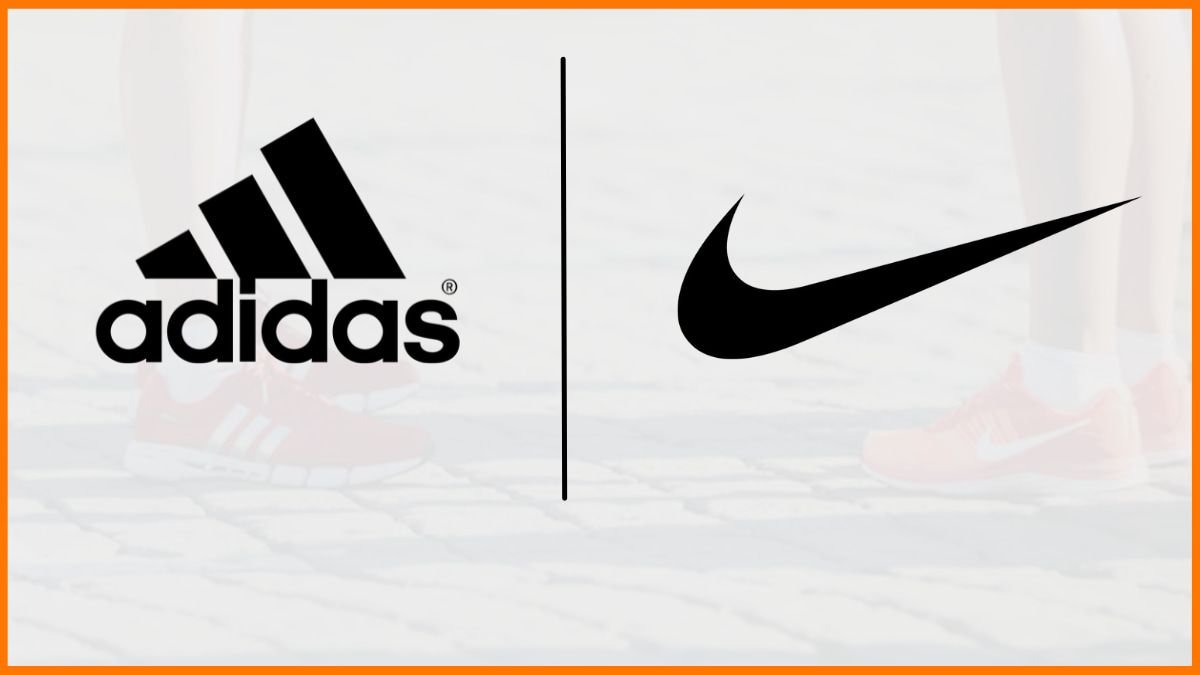
Boost Your Run - 2013

Adidas started the "Boost Your Run" campaign to tell people about its special cushioning in running shoes called Boost. Boost makes runners feel more comfortable and gives them extra energy. Now, Boost is a big part of Adidas running shoes and is used in many other sports. The campaign was like the beginning of talking about Boost, and since then, Adidas has kept making it better and telling people more about it in new campaigns and when they release new products.
Here to Create - 2016

In 2016, Adidas started the "Here to Create" campaign all around the world. They wanted to encourage and inspire people, especially women, to be creative and express themselves through sports and art. The campaign showed that everyone, no matter who they are, can be creative and talented. Adidas set a good example by including and celebrating people from different backgrounds. This campaign was part of Adidas' ongoing work to support and lift up women in sports and creative activities.
Run For The Oceans - 2018

The "Run for the Oceans" campaign was a partnership between Adidas and Parley for the Oceans, a group focused on highlighting the issues of marine pollution and plastic waste in our oceans. The campaign's goal was to fight against plastic pollution and encourage sustainability . It did this by involving people worldwide in a running event and using recycled plastic materials in Adidas products.
She Breaks Barriers - 2018

In 2018, Adidas introduced the "She Breaks Barriers" campaign, concentrating on empowering and backing female athletes while challenging stereotypes in sports. The campaign sought to inspire women to conquer challenges and reach their goals in both sports and life. Through "She Breaks Barriers," Adidas aimed not only to advocate for gender equality but also to establish a supportive and inclusive atmosphere for women in the realm of sports.
Superstar - 2023
Adidas Marketing Campaigns - Superstar
Adidas Originals launched a new worldwide brand idea called "We Gave the World an Original. You Gave Us a Thousand Back" to honor the Trefoil symbol that's been part of its marketing and products for over 50 years. The campaign, making some changes to Trefoil's look, focuses on promoting three iconic shoe models—Superstar, Gazelle, and Samba. Through three short films, it tells the story of how these shoes have become culturally important over time.
Covid-19 Marketing Strategy
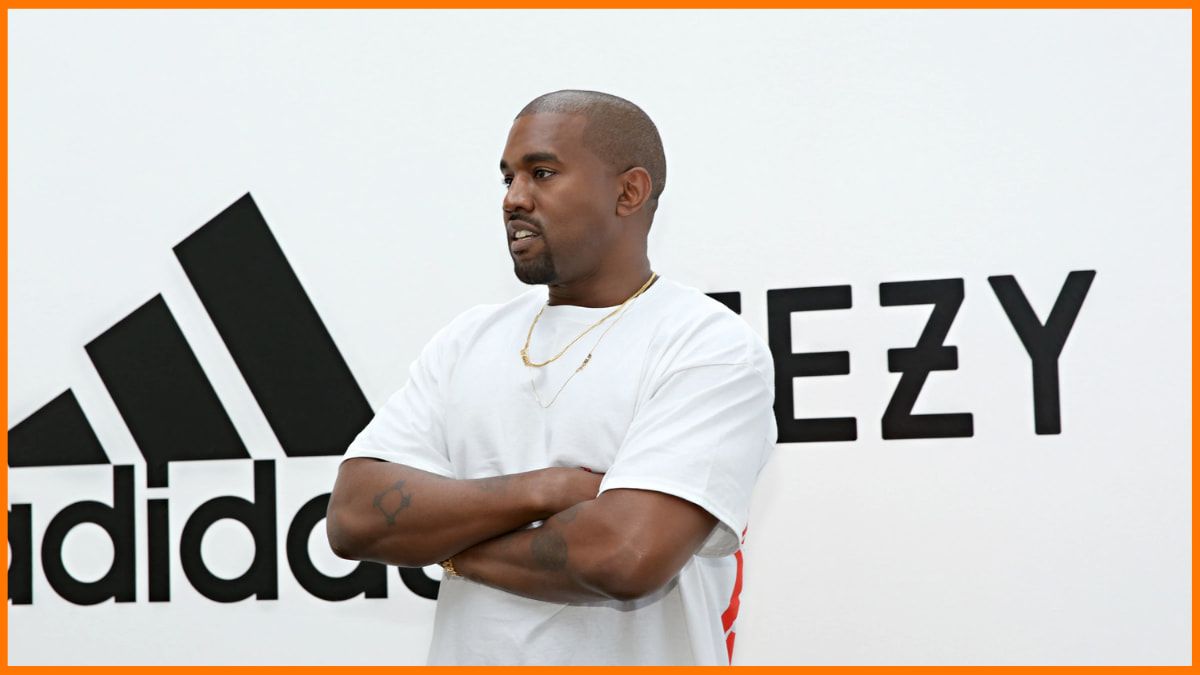
At the very beginning of Covid-19, brands like Adidas and Nike reduced the hiring of people across landscapes. Adidas reduced it by around 40% by March 2020. But soon after one month, in May, Adidas started hiring again as the brand received great data and analytics numbers.
Adidas enhanced its direct-to-consumer abilities by repositioning 700 jobs around different segments of E-commerce . This basically showed how Adidas raced to drive more sales through very successful digital shopping.
Apart from this, Adidas collaborated with many prominent artists, such as Kanye West and Beyonce , to launch its newest models.
Adidas opted for a very distinct yet profitable strategy to deal with the COVID-19 situation.
Adidas' competitive strategy is employed with great efficiency to build its company into the best sports brand in the world, regardless of how competitive the environment gets around it. The brand is using various strategies and tactics such as vigorous manufacturing, digital platforms, technology, innovation, collaboration, and many others. Through these, Adidas is moving towards greater heights.
What is the brand strategy of Adidas?
Adidas focuses on three main strategy pillars: speed, urbanization, and creative innovation.
What makes Adidas unique?
Adidas' USP is that it blends cutting-edge tech and design for unique sports apparel and footwear.
What makes Adidas different from its competitors?
Adidas stands out with its focus on innovation, sustainability, and athlete-centric design.
What is Adidas' pricing strategy?
Adidas employs a high-low pricing strategy. They generally keep prices higher than their competitors, but the company uses promotional discounts to offer lower prices and attract consumers.
Who are Adidas' main customers?
Adidas targets customers of upper-middle-class/high-end customers.
Must have tools for startups - Recommended by StartupTalky
- Manage your business smoothly- Google Workspace
Transforming Customer Experiences: A Guide to Implementing Conversational AI
This article has been contributed by Abhinandan Jain, Chief Growth Officer, Startek. Conversational AI, the technology powering chatbots and virtual assistants, is rapidly reshaping customer interactions. Imagine a tireless AI assistant, available 24/7, that personalizes the customer journey, answers questions with ease, and even streamlines lead generation. Studies show
The Transformative Role of Artificial Intelligence in Education: Applications and Impacts
This article has been contributed by Vivek K Singh, Co-founder and CEO, Careerera. Before delving into Ai’s role in the education sector, let’s begin by defining this technology. Artificial Intelligence or AI enables machines to execute tasks typically associated with human cognition. AI-powered systems have the capability to
How to Network Effectively as an Intern: Building Connections and Expanding Opportunities
This article has been contributed by Sonica Aron, Founder, Marching Sheep. Internships are a very special time in any young professional’s life. Not only do they as act as a passage from them being carefree students to responsible and accountable contributors, but for many aspiring professionals this is when
Revolutionising Corporate Wellness: How FITPASS is Addressing India's Sedentary Workforce Challenge
This article has been contributed by Mr. Akshay Verma, Co-founder of FITPASS. In today's digitally-driven society, India's workforce is grappling with a pressing challenge: the sedentary lifestyle prevalent in corporate environments. Recognising the severe implications of this inactive lifestyle, which experts globally equate to be as detrimental as smoking, FITPASS
We use cookies to improve your experience on our site. Cookies enable you to enjoy certain features, social sharing functionality and to tailor messages and display ads to your interests (on our site, and others). Cookies and Matomo also help us understand how our site is being used. Find out more in our cookie statement .
- Annual Report 2019
- Annual Report 2018
- Annual Report 2017
Topics filter
- Executive and Supervisory Board
- People & Culture
- Sustainability
- Corporate Governance
- Sourcing & Supply Chain
- No filter selected.
- en At a Glance
- At a Glance Targets – Results – Outlook
- At a Glance Financial Highlights 2019
- At a Glance 2019 Stories
- 2019 Stories Collaborating with the Best
- 2019 Stories Major Product Launches
- 2019 Stories Eco-Innovation & Consumer Engagement
- 2019 Stories adidas LDN: The Most Digital adidas Store to Date
- 2019 Stories 70 Years of adidas & New Work Spaces
- At a Glance About this Report
- en To our Shareholders
- To our Shareholders Letter from the CEO
- To our Shareholders Executive Board
- To our Shareholders Supervisory Board
- To our Shareholders Supervisory Board Report
- To our Shareholders Corporate Governance Report
- To our Shareholders Compensation Report
- Compensation Report Executive Board Compensation
- Compensation Report Supervisory Board Compensation
- To our Shareholders Our Share
- en Group Management Report – Our Company
- Group Management Report – Our Company Corporate Strategy
- Corporate Strategy adidas Brand Strategy
- Corporate Strategy Reebok Brand Strategy
- Corporate Strategy Sales and Distribution Strategy
- Group Management Report – Our Company Global Operations
- Group Management Report – Our Company Innovation
- Group Management Report – Our Company People and Culture
- People and Culture People Strategy
- People and Culture Attraction and Retention of Talents
- People and Culture Role Model Leadership
- People and Culture Diversity and Inclusion
- People and Culture Culture
- People and Culture Employee Population
- Group Management Report – Our Company Sustainability
- Sustainability Our Approach
- Sustainability Our Progress
- Our Progress Product Safety and Transparency
- Our Progress Environmental Impacts
- Our Progress Materials and Processes
- Our Progress Human Rights
- Our Progress Supply Chain
- Group Management Report – Our Company Non-Financial Statement
- en Group Management Report – Financial Review
- Group Management Report – Financial Review Internal Management System
- Group Management Report – Financial Review Business Performance
- Business Performance Economic and Sector Development
- Business Performance Income Statement
- Business Performance Statement of Financial Position and Statement of Cash Flows
- Business Performance Treasury
- Business Performance Financial Statements and Management Report of adidas AG
- Business Performance Disclosures persuant to German Commercial Code
- Group Management Report – Financial Review Business Performance by Segment
- Business Performance by Segment Europe
- Business Performance by Segment North America
- Business Performance by Segment Asia-Pacific
- Business Performance by Segment Russia/CIS
- Business Performance by Segment Latin America
- Business Performance by Segment Emerging Markets
- Group Management Report – Financial Review Outlook
- Group Management Report – Financial Review Risk and Opportunity Report
- Risk and Opportunity Report Illustration of Risks
- Risk and Opportunity Report Illustration of Opportunities
- Group Management Report – Financial Review Management Assessment
- en Consolidated Financial Statements
- Consolidated Financial Statements Consolidated Statement of Financial Position
- Consolidated Financial Statements Consolidated Income Statement
- Consolidated Financial Statements Consolidated Statement of Comprehensive Income
- Consolidated Financial Statements Consolidated Statement of Changes in Equity
- Consolidated Financial Statements Consolidated Statement of Cash Flows
- Consolidated Financial Statements Notes
- Notes General Information
- General Information 01 » General
- General Information 02 » Summary of Significant Accounting Policies
- General Information 03 » Discontinued Operations
- General Information 04 » First-Time Consolidation/Disposal of Subsidiaries as well as Assets and Liabilities
- Notes Notes to the Consolidated Statement of Financial Position
- Notes to the Consolidated Statement of Financial Position 05 » Cash and Cash Equivalents
- Notes to the Consolidated Statement of Financial Position 06 » Short-Term Financial Assets
- Notes to the Consolidated Statement of Financial Position 07 » Accounts Receivable
- Notes to the Consolidated Statement of Financial Position 08 » Other Current Financial Assets
- Notes to the Consolidated Statement of Financial Position 09 » Inventories
- Notes to the Consolidated Statement of Financial Position 10 » Other Current Assets
- Notes to the Consolidated Statement of Financial Position 11 » Property, Plant and Equipment
- Notes to the Consolidated Statement of Financial Position 12 » Right-of-Use Assets
- Notes to the Consolidated Statement of Financial Position 13 » Goodwill
- Notes to the Consolidated Statement of Financial Position 14 » Trademarks and other Intangible Assets
- Notes to the Consolidated Statement of Financial Position 15 » Long-Term Financial Assets
- Notes to the Consolidated Statement of Financial Position 16 » Other Non-Current Financial Assets
- Notes to the Consolidated Statement of Financial Position 17 » Other Non-Current Assets
- Notes to the Consolidated Statement of Financial Position 18 » Borrowings and Credit Lines
- Notes to the Consolidated Statement of Financial Position 19 » Other Current Financial Liabilities
- Notes to the Consolidated Statement of Financial Position 20 » Other Provisions
- Notes to the Consolidated Statement of Financial Position 21 » Lease Liabilities
- Notes to the Consolidated Statement of Financial Position 22 » Accrued Liabilities
- Notes to the Consolidated Statement of Financial Position 23 » Other Current Liabilities
- Notes to the Consolidated Statement of Financial Position 24 » Other Non-Current Financial Liabilities
- Notes to the Consolidated Statement of Financial Position 25 » Pensions and Similar Obligations
- Notes to the Consolidated Statement of Financial Position 26 » Other Non-Current Liabilities
- Notes to the Consolidated Statement of Financial Position 27 » Shareholders’ Equity
- Notes to the Consolidated Statement of Financial Position 28 » Share-Based Payment
- Notes to the Consolidated Statement of Financial Position 29 » Non-Controlling Interests
- Notes to the Consolidated Statement of Financial Position 30 » Financial Instruments
- Notes Notes to the Consolidated Income Statement
- Notes to the Consolidated Income Statement 31 » Other Operating Income
- Notes to the Consolidated Income Statement 32 » Other Operating Expenses
- Notes to the Consolidated Income Statement 33 » Cost by Nature
- Notes to the Consolidated Income Statement 34 » Financial Income/Financial Expenses
- Notes to the Consolidated Income Statement 35 » Hyperinflation
- Notes to the Consolidated Income Statement 36 » Income Taxes
- Notes to the Consolidated Income Statement 37 » Earnings per Share
- Notes Additional Information
- Additional Information 38 » Segmental Information
- Additional Information 39 » Additional Cash Flow Information
- Additional Information 40 » Other Financial Commitments and Contingencies
- Additional Information 41 » Related Party Disclosures
- Additional Information 42 » Other Information
- Additional Information 43 » Information relating to the German Corporate Governance Code
- Additional Information 44 » Events after the Balance Sheet Date
- Consolidated Financial Statements Shareholdings
- Consolidated Financial Statements Responsibility Statement
- Consolidated Financial Statements Independent Auditor’s Report
- Consolidated Financial Statements Limited Assurance Report
- en Additional Information
- Additional Information Ten-Year Overview
- Additional Information Declaration of Support
- Additional Information GRI Standard Content Index
- Additional Information Financial Calendar
Creating innovative concepts to meet the needs of athletes and consumers is a prerequisite to strengthening our market position in the sporting goods industry and a premise to being the best sports company in the world. We therefore remain highly committed to maintaining a full and innovative concept pipeline, bringing new groundbreaking technologies and processes to life, investing into sustainable enablers and exploring the possibilities of digitalization across our entire value chain. True to the vision of creative collaboration, our innovation approach is widely based on our Open Source mindset.
MEETING THE NEEDS AND EXPECTATIONS OF OUR CONSUMER
The modern innovation landscape extends beyond product and increasingly requires innovation teams to consider the development of experiences and services, as well as the provision of greater levels of transparency and direct integration of our consumer through co-creation.
In partnership with our trend and cultural insights teams, foresight and trend analysis are shared on an ongoing basis, documenting shifts in society and culture. This provides the starting point to build concepts of relevance.
The FUTURE team at adidas is tasked to develop a strong portfolio of innovation capabilities such as new materials, production processes and consumer-centric scientific research to provide a platform for meaningful concept development. Projects are incubated within the company and aligned to the broader sourcing, marketing, creative and strategic functions across the organization, ensuring a robust and impactful innovation pipeline.
INNOVATION APPROACH BASED ON OPEN SOURCE MINDSET
Our approach to innovation reflects our commitment to the Open Source mindset, where we seek to build value together with athletes and consumers, universities and innovative companies as well as national and international governments and research organizations. In addition to opening up our doors to valuable feedback, we also get inspired by the input from knowledgeable partners:
- BASF: Together with BASF, we manage and enhance BOOST, a cushioning technology designed to deliver maximum energy return, responsiveness and comfort to athletes.
- Carbon: Together with Carbon, a Silicon Valley-based tech company, we are revolutionizing product creation through hardware , software and molecular science, and have enabled mass production of additively manufactured components, coming to life with adidas 4D.
- Fashion for Good: Together with Fashion for Good, a global cross-brand initiative to make all fashion sustainable, we are accelerating sustainable innovation in the apparel industry through, among other things, mentorship of and collaboration with circular start-ups.
- Oechsler: Together with Oechsler, an expert in high-tech automated manufacturing of technical components and assemblies, we operated our Speedfactories in Ansbach, Germany, and Atlanta, USA. However, in 2019 we decided to deploy the Speedfactory technology at Asian suppliers. Our collaboration with Oechsler will continue in other manufacturing areas.
- Parley for the Oceans: Together with Parley for the Oceans , we are developing products partially created from upcycled plastic waste, intercepted before it reaches the ocean from beaches and coastal communities.
- Platform A at Station F: In January 2019, we launched our global sports accelerator program Platform A. Station F is the biggest start-up campus in the world, based in our key city Paris, France. The accelerator aims to use the innovative power of the global start-up scene to create the best digital innovations in sport. The first generation of start-ups started the program in January and presented their digital pilots in September 2019. In the meantime, adidas onboarded a second generation that will develop new concepts and identify opportunities in the areas of women empowerment, sustainability, retail and e-commerce.
FIVE PILLARS OF INNOVATION
Within our innovation principles, we identified five strategic pillars which enable us to develop the best products and experiences for athletes and consumers, while at the same time drive game-changing innovations in the fields of manufacturing, digital and sustainability.
Athlete innovation
Our clear focus is to produce the best and most innovative products for athletes to enable them to perform at their very best. To achieve this, we work closely together with athletes and teams as well as numerous universities and innovative companies, to deliver against the needs of our target consumer.
Manufacturing innovation
To simplify manufacturing, enable product innovation and increase speed-to-market capabilities, the company’s innovation activities are also focused on new manufacturing technologies. Our goal is to combine state-of-the-art information technology with new manufacturing processes and innovative products. For this reason, we commit ourselves to long-term cooperation with innovative companies and organizations to take a leading role in manufacturing innovation.
Digital and experience innovation
The adidas brand was amongst the first in the industry to comprehensively bring data analytics to the athlete. With decades of continuous investment in sports science, sensor technology and digital communication platforms, adidas has already taken a leading role in terms of changing the sporting goods industry through technology. With the increasing speed of digitalization, this field will remain one of our core areas.
Sustainability innovation
Our commitment to manage our business in a responsible way has long been one of the company’s principles. To stay at the forefront of sustainable innovation, adidas is pursuing a proactive approach to establish internationally recognized best practices and achieve scalable improvements. As part of our sustainability roadmap, we have set ourselves the target for 2020 to invest in materials, processes and innovative machinery which will allow us to upcycle materials into products and reduce waste. In 2019, we further focused on taking responsibility for the entire product life cycle and established a clear game plan for moving toward a circular business model. see Sustainability
Female athlete innovation
Our long-term commitment to the female athlete continues to be a focus for the company. To fuel the growth of our women’s business, we have taken a holistic approach to understanding the female athlete’s performance and non-performance needs throughout her active life. We therefore look at this target group as an integrated part of our business but from a separate and unique angle. With a focus on the female consumer, it is crucial to fully understand the specific product needs of the female athlete to help unlock her full potential. To enable this, we are working to establish a robust network of industry leaders and academic experts with our ‘Path to Expert’ approach, which will help to accelerate the building of insights and foresights that keep us at the forefront of product innovation.
COMMERCIALIZATION OF INNOVATIONS
We believe developing industry-leading technologies and consumer experiences is only one aspect of being an innovation leader. Equally important is the successful commercialization of those innovative concepts:
- Parley Ocean Plastic: Products made of Parley Ocean Plastic focus both on the needs of our athletes, by living up to their performance promise, and on the needs of the world, by helping to protect our oceans from marine plastic pollution. We have taken sustainability to the product level and continue to roll it out across our product portfolio. In 2019, we made more than eleven million pairs of shoes containing Parley Ocean Plastic , across various footwear franchises in both Sport Performance and Sport Inspired . In addition, nearly three million pieces of our 2019 apparel offering featured Parley Ocean Plastic, including jerseys for high-profile teams such as Real Madrid, Bayern Munich, Juventus Turin and Manchester United.
- Futurecraft Loop: Futurecraft Loop is our first 100% recyclable performance shoe made entirely from one material (TPU), using no glue or solvent. The first generation of the shoe was rolled out in April 2019 as part of a global beta program with consumers from across the world’s major cities. They were asked to test and return the shoes to start the recycling process. In November 2019, we introduced the second generation of Futurecraft Loop. We will take the learnings from the recycling process to further develop the concept and to prepare for the commercial release in 2021. Futurecraft Loop was recognized by Time Magazine as one of the ‘Best Inventions 2019’.
- adidas 4D: The high-performance footwear produced under the adidas 4D concept features midsoles crafted with light and oxygen using Digital Light Synthesis, a unique technology developed by Carbon. The midsole pioneers a digital footwear component creation process that eliminates the necessity of traditional prototyping or molding. With the new technology, adidas brings additive manufacturing in the sports industry into a new dimension. After having produced more than 100,000 pairs of this high-performance footwear in 2018, we continued to increase volumes in 2019 and intend to further expand production in the future. In the past two years, adidas 4D has gone from a conceptual innovation to a running shoe that has been made available in larger quantities and multiple variations.
- Creators Club: This new digitally enabled membership program rewards loyal consumers with invitations to exclusive events and access to limited-edition products. In addition, it enhances the e-commerce shopping experience for members through an even faster checkout process and new order-tracking options. The program allows us to deepen the relationship with our consumers and to gain valuable insights into their expectations and needs. Creators Club launched in the US toward the end of 2018, and is now live in France, Germany, Japan, the UK and Singapore.
- adidas by Stella McCartney Infinite Hoodie and Biofabric Tennis Dress: With the adidas by Stella McCartney Infinite Hoodie, we presented the first commercially produced 100% recyclable performance garment made of 60% NuCycl lyocell and 40% organic cotton, which are completely recyclable fabrics. We have also already taken the first steps toward exploring solutions to create products that are made with nature, and can, at some point, also return to nature. The adidas by Stella McCartney Biofabric Tennis Dress is a prototype concept made with a cellulose blended yarn and certified Microsilk, a protein-based yarn that is made of completely renewable inputs, which has the ability to fully biodegrade at the end of its life. see Sustainability see Adidas Brand Strategy
- Forever Floatride Grow: At the end of 2019, Reebok announced Forever Floatride Grow – the brand’s first plant-based performance running shoe and latest example of sustainability innovation. The shoe is made with castor beans, algae, eucalyptus trees and natural rubber and thus builds on Reebok’s successful Cotton + Corn lifestyle collection of footwear.
- Infinite Play: Building on learnings from take-back pilots in Brazil, Canada, and some of our key cities in Europe and the US, adidas is exploring infrastructure for product bring-back and recycling, with partners, governments and regulatory bodies. 2019 saw the launch of ‘Infinite Play’ in the UK to extend the useful life of products by passing them on to new users, thus avoiding waste. The initiative engages consumers in returning used items by rewarding them with gift cards and Creators Club points.
- AM4 Series: The ‘adidas made for’ (AM4) products were created at the adidas Speedfactory facilities in Ansbach and Atlanta. In 2019, we continued to deliver launches jointly with creators supporting moments that matter for our consumers, e.g. limited editions around the Marvel universe and for Bayern Munich. The concept was included into the adidas offerings to Footlocker and exclusive launches with our Creators Club. Going forward, Speedfactory technologies will be used at two of our suppliers in Asia that will allow for more variations of Speedfactory footwear models in the future.
NEW PRODUCT LAUNCHES GENERATE THE MAJORITY OF SALES
As in prior years, the majority of sales were generated with products newly introduced in the course of 2019. New products tend to have a higher gross margin compared to products which have been in the market for more than one season.
In 2019, brand adidas and Reebok sales were again driven by the latest product offerings. At brand adidas, products launched during the course of the year accounted for 77% of brand sales (2018: 74%), while only 3% of sales were generated with products introduced three or more years ago (2018: 3%). At Reebok, 67% of footwear sales were generated by products launched in 2019 (2018: 67%), while 11% of footwear product sales relate to products introduced three or more years ago (2018: 11%).
R&D EXPENSES deCREASE 1%
Expenses for research and development (R&D) include expenses for personnel and administration, but exclude other costs, for example costs associated with the design aspect of the product creation process or the majority of costs related to company-wide Open Source initiatives. In 2019, as in prior years, all R&D costs were expensed as incurred. The company’s R&D expenses decreased 1% to € 152 million from € 153 million in the prior year.
R&D expenses
€ 152 m
In 2019, R&D expenses as a percentage of sales equated to 0.6% (2018: 0.7%). The number of people employed in R&D activities at December 31, 2019, was 1,007 (2018: 1,041).
(XLS:) Download
R&D expenses (€ in millions)
R&D expenses (in % of net sales)
R&D employees
A product category which comprises equipment that is used rather than worn by the consumer, such as bags, balls, or fitness equipment.
Speedfactory
Speedfactory stands for an accelerated manufacturing process of high-performance sports shoes enabled by latest manufacturing technology that was tested at the adidas Speedfactories in Ansbach, Germany, and Atlanta, USA. adidas opened both factories together with Oechsler in 2017. At the end of 2019, adidas started to deploy its Speedfactory technologies to produce athletic footwear at two of its suppliers in Asia. Production at the Ansbach and Atlanta Speedfactories will be discontinued by April 2020. This will enable adidas to continue to respond to short-term trends in demand while using production capacities more flexibly and economically and expanding the range of products with short production times faster. Manufacturing processes will continue to be developed, improved and tested in the adiLab at the adidas production site in Scheinfeld.
Parley for the Oceans
Parley for the Oceans is an environmental organization and global collaboration network. Founded in 2012, Parley aims to raise awareness for the beauty and fragility of the oceans, and to inspire and empower diverse groups such as pacesetting companies, brands, organizations, governments, artists, designers, scientists, innovators and environmentalists in the exploration of new ways of creating, thinking and living on our finite, blue planet.
Parley Ocean Plastic
Parley Ocean Plastic is a material created from upcycled plastic waste that was intercepted from beaches and coastal communities before reaching the ocean. Parley for the Oceans works with its partners to collect, sort and transport the recovered raw material (mainly PET bottles) to our supplier who produces the yarn, which is legally trademarked. It is used as a replacement for virgin plastic in the making of adidas x Parley products.
Sport Performance
‘Sport Performance’ stands for the categories training, running, football, basketball and heartbeat sports such as outdoor, swim, tennis and US sports.
Sport Inspired
‘Sport Inspired’ stands for fashion inspired by sport – also known as ‘sports lifestyle’. It draws inspiration from adidas’ rich archives and legacy. Sport Inspired stands for Originals, Y-3, Statement and Yeezy.
Creators Club
Creators Club is a membership program that helps us deepen the relationship with our consumers. Linking all adidas apps, events, communities and channels into one single profile, the program rewards members with points for interacting with the brand, e.g. when making a purchase or using the ‘adidas Running by Runtastic’ or ‘adidas Training by Runtastic’ apps. Depending on the number of points, exclusive benefits are unlocked, including access to hype sneaker and apparel drops or invitations to special events.
Do you know that 'Speed' is a strategic priority?
Adidas Segmentation, Targeting, and Positioning
Discover more helpful information.
1. Introduction
Adidas is a worldwide firm that develops and manufactures shoes, clothes, and accessories. It was founded and is based in Germany. Many people appreciate Adidas since they sell a variety of goods such as men's and women's apparel, footwear, and collectibles. Adidas' advantages and services include constant attempts to improve the brand to keep its position in a competitive market by increasing quality, appearance, and designs to meet customer requirements.
Adidas is a multinational organization that specializes in being innovative to attract more customers and meet its sales goals. The goal of this research is to teach you how Adidas segments, targets, and positions their market , as well as how their new and better goods are being received by their targeted customers.
2.Market Segmentation of Adidas
Adidas separates its market into multiple categories depending on different consumers' choices and likings. Market segmentation can be separated into different segments of consumers depending on demographic segmentation, geographic segmentation, psychographic segmentation, or behavioral segmentation criteria. They may require a different product altogether or have a marketing mix of perks or benefit from the items they buy. It also allows for a more accurate determination of market opportunities, as well as the examination of market gaps. Adidas Originals offers limited-edition daily ware and cultural fashion apparel and footwear that are typically more colorful but less athletic in appearance, whereas the standard Adidas caters to individuals who want to participate in sports.
Customers with a better social position are more likely to buy Adidas items that are more expensive. Customers with a lower social position have the option of purchasing things that are more inexpensive to them. Customers who enjoy sports are more likely to purchase sporting goods from Adidas, while customers who do not enjoy sports are more likely to purchase things from Nike. Customers that appreciate street-styled apparel would most likely purchase their desired items from Adidas Originals or Style, as they share similar interests. This occurs because they have similar behavioral patterns and may relate to one another.
Adidas offers clothing, jewelry, and footwear for both men and women to cater to a larger variety of age and gender groups and hence attract more customers. Adidas will be able to strengthen its capacity to customize products or services to the specific needs of particular market segments, as well as the organization's ability to compete successfully and financially, perhaps avoiding powerful competition.
3. Targeting of Adidas
Adidas aims to appeal to current categories of consumers that enjoy and are passionate about health and fitness sports, as well as those who have been loyal to the company from its inception. They are aimed towards athletes or young individuals who enjoy sports between the ages of 20 and 30. Adidas is focusing on 13-18-year-old athletes because they feel they are the future generation of athletes who will develop the brand and are the most important customer segment. Nevertheless, the company is also very famous for those aged 40 to 65. Because of the amazing high-end quality and brand awareness and recognition of Adidas items, they are frequently more expensive.
As a result, they cater to people belonging to mostly upper-middle-class and high-end clientele. Mobile phones have brought several new lifestyle goods to Adidas originals' target market in recent years, benefiting the company by expanding its client base. Adidas also caters to a smaller segment of clients who are not into athletics but buy shoes or apparel as a statement fashion piece and are between the ages of 15 and 25 years old. Adidas can't connect with all clients in such a wide and diversified market because if they try to reach out to everyone, their message will be muddled, and they will not be able to please any customers.
4. Positioning of Adidas
Positioning is a wonderful marketing approach that allows a company to highlight its benefits and establish a picture of the firm's services in the minds of customers. Adidas is very concerned about its clients, which is why diversity, honesty, performance, and enthusiasm are among the company's key principles. Adidas presents itself as a major sportswear brand and attempts to build its reputation by creating and selling qualified items, providing swift service, and having a lengthy history.
The business views itself as its brand for those who aspire to be great football players, athletes, and so on. This method leads people to assume that wearing Adidas items is one of the keys to winning. That is why the majority of this company's advertisements are uplifting and inspiring. Adidas is one of the companies that set standards for the rest of the market because it never stops working on the quality and distinctiveness of its products, and it seeks to delight its clients with rapid, attentive, and peppy service.
5. Mind Map
Market segmentation is the division of large marketplaces into groups with comparable requirements and desires. The goal of segmentation is to obtain a deep understanding of the consumer, establish a competitive edge, and then better serve the client's requirements and wishes. Adidas employs user and benefit-based positioning methods to build a distinct image in the minds of potential customers. Adidas can keep its brand identity by stressing the value of high-quality items from a well-known brand. The following is a breakdown of the portfolio.
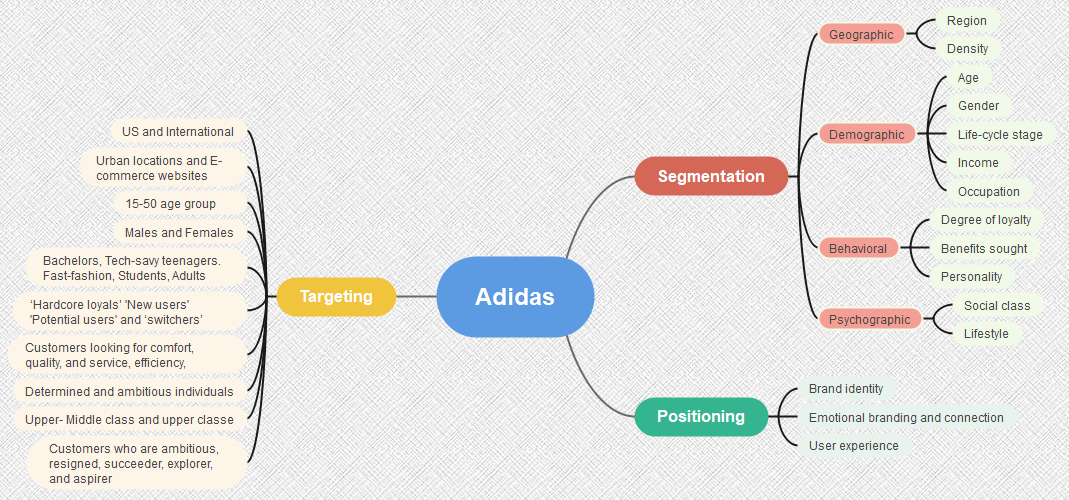
6. Key Takeaways
In conclusion, Adidas produces high-quality, long-lasting goods. One of the most significant aspects of Adidas' marketing strategy is market segmentation, targeting, and positioning. Adidas' tagline, "Nothing is ever impossible," reinforces the brand's ideology. I think that with continued hard work and perseverance, Adidas will probably achieve and soar to new heights and become the world's top sports brand. "With brands developed on a commitment for sports and a sporty culture, the Adidas Group aspires to be the global leader in the sporting goods sector.
Adidas is dedicated to improving our competitive position by consistently enhancing our brands and goods. After studying their clients' purchasing processes, they discovered that the immersive experience, as well as the availability, accessibility, and variety of product offers, play a critical part in a successful distribution strategy. They made the pieces available to private Label shops to increase their distribution chain. You can make the mind map just like this with EdrawMind 's pre-made template that will help you make the diagram in less than 5 minutes. You also have a lot of options to choose from their pre-made template options and mind map diagrams.
7. References
- Marketing strategy of Adidas
- Positioning of Adidas | STP Analysis of Adidas

Nestlé Market segmentation, targeting, and positioning

KFC Mission and Vision Statement Analysis

SWOT Analysis of Coffee Shop: Examples & Guide

Boeing Mission and Vision Statement Analysis
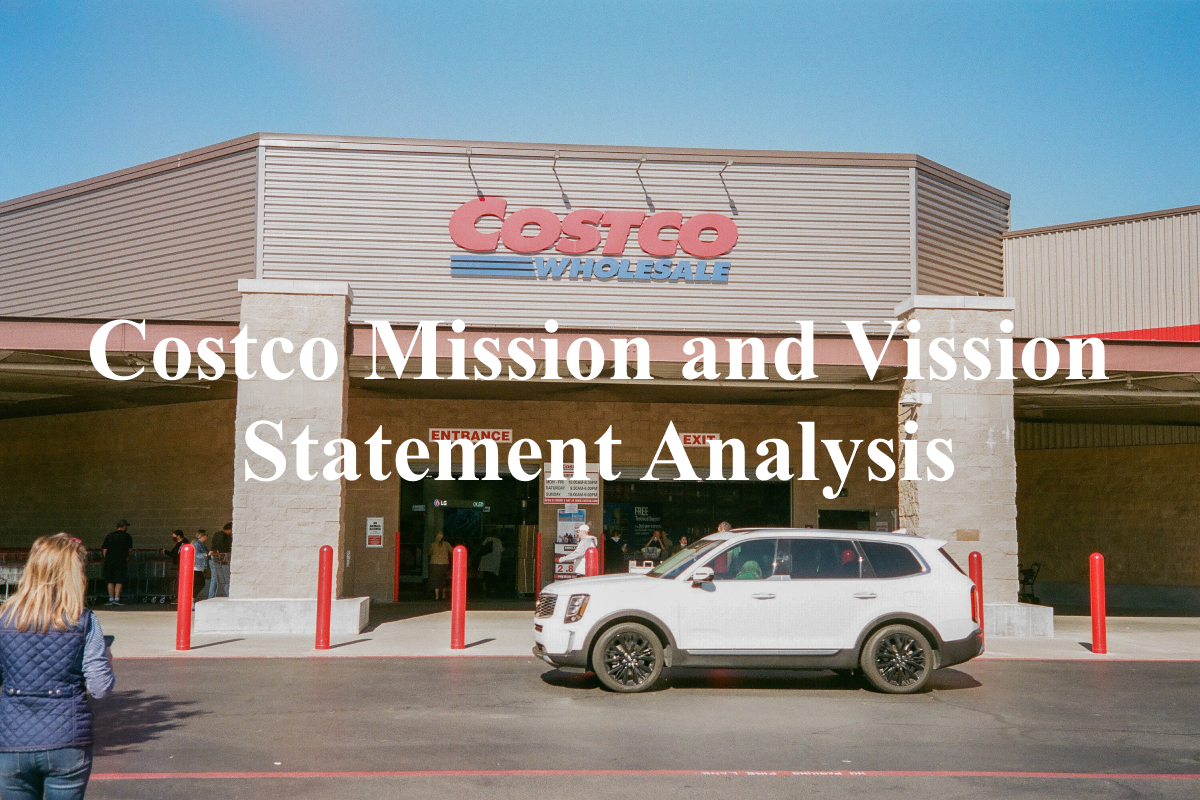
Costco Mission and Vision Statement Analysis
These US companies are best at cutting their emissions to fight climate change

People across America are trying to do their part to fight climate change by buying electric cars, installing solar panels and making decisions large and small that reduce their carbon footprint. Some companies are too.
Those actions can make a big difference: between them, the U.S. industrial and commercial sectors were responsible for 25% of the nation's total carbon dioxide emissions in 2023, according to the U.S. Energy Information Administration. (Transportation still makes up the lion's share at 38%.)
But which companies are doing the best at reducing their carbon footprint? That's a surprisingly difficult question to answer. It's also an important question for customers and investors who want to support companies making climate-friendly strides in their business.
Currently, there are no federal or even state requirements in place requiring companies to disclose how much they’re lowering their greenhouse gas emissions.
To better understand which U.S. businesses are making progress, USA TODAY has partnered with market research firm Statista to create the second annual America's Climate Leaders list. It provides an easy to comprehend, data-driven metric of companies that have significantly decreased their carbon dioxide emissions (adjusted by revenue) between 2020 and 2022.
Since last year’s list , there was a 16% increase in companies meeting the inclusion criteria. The list includes U.S. based companies with more than $50 million in revenue that reported their carbon emissions independently. To make the list, those companies must have reduced their carbon intensity (carbon emissions divided by revenue) by 3% year-to-year.
Why is it so tough to determine which companies are best at reducing their carbon footprint?
In short: The data is messy and inconsistent.
Evaluations of companies' climate impact require deep dives into multiple, sometimes conflicting metrics. That's because there’s no U.S. requirement that companies disclose their emissions, though many do so voluntarily.
“Data availability is getting better,” said Lisa Abels, a senior analyst with Statista who worked on the list.
It could keep improving, too.
Last month, after a two-year effort, the U.S. Securities and Exchange Commission passed new rules requiring some public companies to report their greenhouse gas emissions and climate risks. The final result was less strong than originally proposed and its climate disclosure rules don’t begin until 2026 when the first large companies will be required to include information in their annual reports.
As of 2024 an appeals court had temporarily paused the rules, so it’s not clear when or if they will go into effect.
California has also enacted climate-related reporting requirements for companies doing business in California with total annual revenues in excess of $500 million but it will not take effect until January 2025.
With no national requirements for reporting carbon dioxide pollution currently in effect, having more transparency and data about companies’ emissions is “incredibly important,” said Christian Leuz is a professor at the University of Chicago’s Booth School of Business and a scholar at the Energy Policy Institute. A study he co-authored in 2023 found that if global corporations had to pay for the damages caused by their greenhouse gas production it would cost 44% of their profits .
Data that allows the public to see how emissions relate to companies’ activities and are changing over time lets consumers and investors make informed comparisons between companies – which can have “a real impact,” said Leuz.
“Such benchmarking can create peer pressure, stimulating investors, other stakeholders and customers to call on firms to do more to reduce their emissions. Companies voluntarily making this data public is an important first step,” he said.
Mandates to make such disclosures would “be even better, as it would shine the light on companies with high emissions that are reluctant to provide these data voluntarily,” he added.
How do companies make it on USA TODAY's list of America's Climate Leaders?
The first list, developed last year, began with 2,000 U.S.-based companies which were narrowed to 400 that cut their emissions intensity from 2019 to 2021. For 2024, the list was expanded to 450 companies and looked at their emissions between 2020 and 2022.
The ranking uses these and other indicators to gain a picture of how good a job companies have done at lowering their carbon emissions. Because the analysis includes 2020, during the onset of the COVID-19 pandemic, some of the metrics are difficult to evaluate because of the hit the global economy took, resulting in sharp drops in emissions worldwide.
This year’s analysis compares companies' core emissions adjusted by revenue for the years 2020 and 2022. This measure is called emission intensity. As the pandemic unfolded, 2020 was an especially bad year for revenue for many companies, making 2022 emission intensity lower but that’s partly driven by an increase in revenues after the pandemic years, said Abels.
“The absolute emissions didn’t go down as much I expected or hoped for, which will be important for years to come,” she said. The distortions caused by the pandemic are still visible in this year’s data. Some may still be present in the data used for the rankings in next year's but should be entirely gone by 2026, she said.
Overall, U.S. emissions numbers across the board have been coming down, with the number of million metric tons of carbon dioxide released by the United States down 6.6% since 2019. Much of that decrease came because U.S. electricity is getting cleaner.
What companies ranked highest on USA TODAY's list of America's Climate Leaders?
At the very top of the Climate Leaders list is Dayforce (formerly called Ceridian), a human resources and software company.
By switching to 100% renewable energy across its global operations, Dayforce reduced its greenhouse gas emissions from more than 10,000 metric tons CO2 equivalents in 2020 to less than 500 metric tons CO2 equivalents in 2022.
It is followed by T-Mobile, which was on top of last year’s list. The third spot goes to financial company Cboe Global Markets.
How companies were chosen
The rankings began with a list of more than 2,000 US-based companies with revenue of more than $50 million in 2022. Of those, 700 reported their emissions data, making a verifiable ranking possible.
Here are some of the data and considerations used in the rankings:
- Emission intensity : The amount of greenhouse gas a company produced relative to its revenue. This helps put big companies and small companies on a level playing field.
- Annualized reductions in emission intensity : Calculated between 2020 and 2022. Companies that showed low reductions were not considered.
- Carbon disclosure rating : A measure of a company’s environmental sustainability. These rankings are administered by CDP, a nonprofit that runs a global disclosure system for companies’ environmental impacts.
- Other criteria : Some enterprises were excluded if known business practices suggested they couldn’t be seen as a climate leader.
- Data used : Scope 1 and 2 emissions, based on the Greenhouse Gas Protocol, the world’s most widely used greenhouse gas accounting standard.
The full, interactive list below allows readers to view a variety of criteria, including year-over-year reduction of emission intensity, emission intensity, how many tons of CO2 equivalents the company emitted, total emissions reduction, and whether a company participated in two highly regarded programs that set targets for and account for emissions, the CDP and Science Based Targets initiative .
- My View My View
- Following Following
- Saved Saved
Indian drugmakers to see FY25 revenue boost in key US market, says India Ratings and Research
- Medium Text

IMPROVED RESULTS
Sign up here.
Reporting by Rishika Sadam
Our Standards: The Thomson Reuters Trust Principles. New Tab , opens new tab

Business Chevron

Capital flows to emerging markets to net $903 billion in 2024, IIF says
Major developing economies are expected to see net capital inflows this year rise by nearly a third to $903 billion, though much of that hinges on global growth holding up, a banking trade group report said.
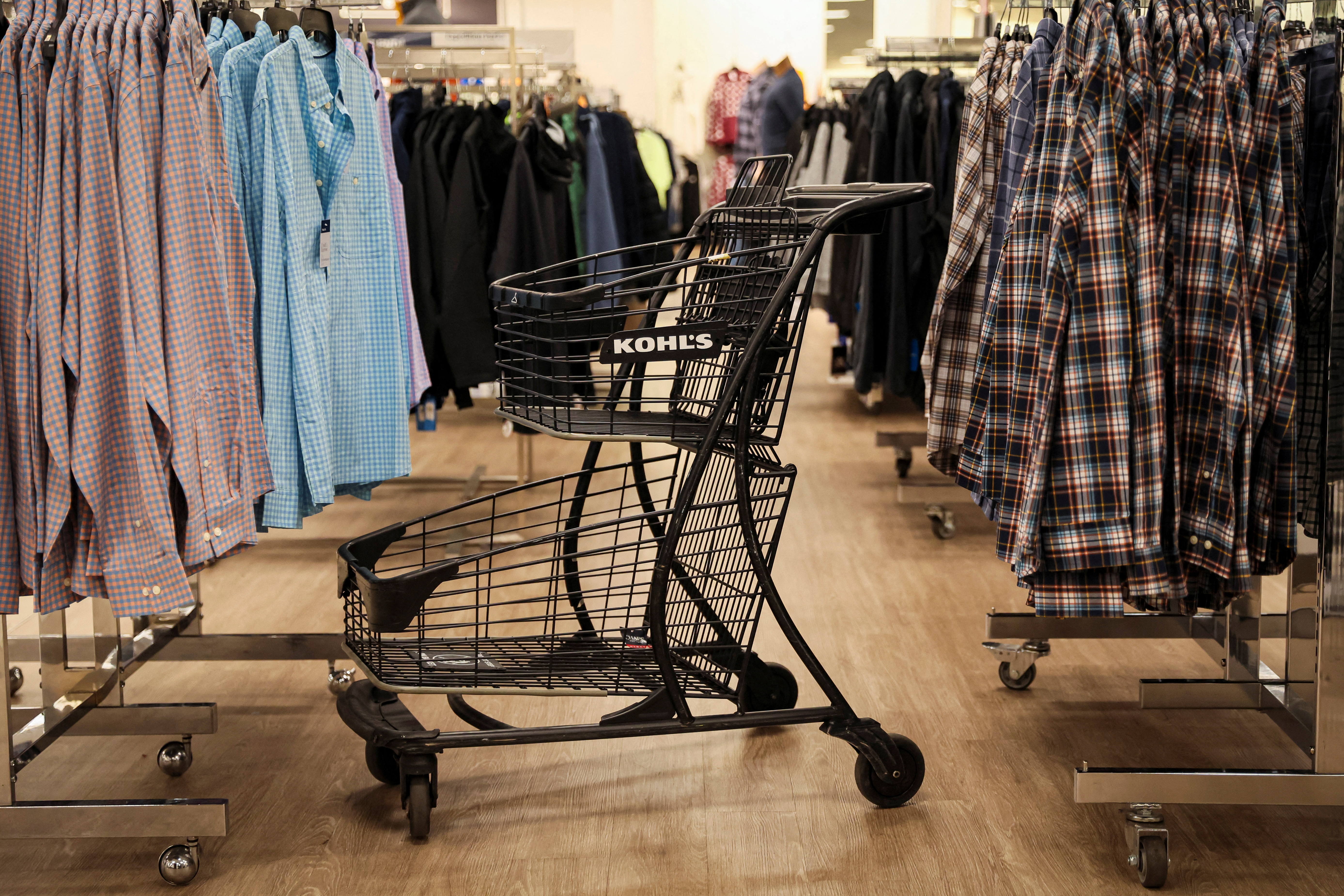
We've detected unusual activity from your computer network
To continue, please click the box below to let us know you're not a robot.
Why did this happen?
Please make sure your browser supports JavaScript and cookies and that you are not blocking them from loading. For more information you can review our Terms of Service and Cookie Policy .
For inquiries related to this message please contact our support team and provide the reference ID below.
- Governments
- Panjiva Platform
- S&P Capital IQ Pro
- XpressFeed™
- United States Trade Data
- Brazil Trade Data
- Central & South America Data
- India Trade Data
- Pakistan Trade Data
- Vietnam Trade Data
- S&P Global
- Demo Request a Demo
Supply Chain Intelligence about:
Mercatus Nova Co.
See Mercatus Nova Co. 's products and customers
Thousands of companies like you use Panjiva to research suppliers and competitors.

Easy access to trade data
U.s. customs records organized by company, explore trading relationships hidden in supply chain data, supply chain map.

Contact information for Mercatus Nova Co.
- soft drinks
- confectionary
- HS 22 - Beverages, spirits and vinegar
- HS 19 - Preparations of cereals, flour, starch or milk; pastrycooks' products
- HS 33 - Essential oils and resinoids; perfumery, cosmetic or toilet preparations
- HS 20 - Preparations of vegetables, fruit, nuts or other parts of plants
- HS 21 - Miscellaneous edible preparations
Sample Bill of Lading
183 shipment records available, thousands of companies use panjiva to research suppliers and competitors.
- Xpressfeed™
- United States
- Central & South America

- Terms of Use
- Privacy Policy
- Cookie Notice
- Cookie Settings
- Do Not Sell My Personal Information

IMAGES
VIDEO
COMMENTS
The Adidas target audience is located internationally, and the company has a market presence in over 160 countries. In 2021, Adidas operated 2,184 retail stores worldwide . The proportion of Adidas net sales is highest in Europe, the Middle East and Africa (37%), followed by North America with 24% and Greater China at 22% .
Abstract. A well-developed and well-executed marketing strategy is important for a company, especially for Adidas in the highly competitive sporting goods industry. Therefore, this essay analyzes ...
Data and analytics play a crucial role in Adidas's marketing strategy. The brand utilizes data-driven insights to track customer behavior, preferences, and interactions. This information allows Adidas to tailor its marketing efforts, ensuring better engagement and conversion rates. Furthermore, Adidas embraces innovative technologies such as ...
Adidas, the renowned sportswear and lifestyle brand, has been able to capture the market with its effective marketing strategy.Understanding the Adidas brand is crucial to comprehending the success behind its marketing efforts. By examining the history of Adidas and its brand identity, we can gain insight into the foundations that have propelled its marketing strategy to new heights.
Creator archetype: Owing to the rapid evolution of sport and sports culture, the adidas brand targets key consumer groups and influencers to create brand desirability and momentum through a well-defined consumer segmentation strategy. The consumer grid comprises six key quadrants (Male Athlete, Female Athlete, Young Creator, Streetwear Hound ...
Adidas employs more than 53,731 people in over 160 countries produce more than 660 million product units every year and generate sales of € 14.5 billion (all figures relate to 2014). These numbers alone can easily suggest that Adidas Group is quite a complex organisation.True. But they keep things simple, lean and fast.
Research and development (R&D) expenditure of the adidas Group worldwide from 2010 to 2023 (in million euros) Premium Statistic adidas Group POS marketing spend 2015-2023
group's strategy: the group operates in the sports apparel, footwear & accessories field. where, according to the 5-forces model, there is a hi gh de gree of rivalry, no significant. power of ...
Adidas Marketing Strategy - Adidas, a multinational sportswear company founded in 1949 by Adolf Dassler, has established itself as one of the world's leading brands in the sports fashion industry.With a strong emphasis on innovation, quality, and style, Adidas has consistently captured the hearts of athletes, sports enthusiasts, and consumers who value both performance and fashion.
Adidas Distribution Strategy. In 2022, E-Commerce (Direct-to-Consumer) contributed to 20% of total revenue . Own Retail (Direct-to-Consumer) accounted for 19% of total revenue in 2022. Wholesale made up the majority of revenue in 2022, at 61%. Adidas Employees. In 2022, the company had 31,477 employees in own retail.
The first part evaluates the marketing strategy of the Adidas while the. second part discusses the marketing mix of the Adidas 4F FWD shoes. 2. Evaluation of the current marketing strategy (PESTLE ...
The two sportswear giants' competition - Adidas vs Nike. Adidas and its main competitor Nike have nurtured their own sports fans in a fierce competition ruled by marketing spending. Consumers are loyal and both products are in high demand, but looking at their marketing strategy, one can find many differences stemming from their business ideology and country of origin.
The Branding Process, Author's source based on Wheeler 2013, p. 102-103 3.1.1. Market Research First, a business needs to understand their current organisational situation and the environment they are operating in. ... 2012, p. 213-210; Kotler & Keller, 2016, p. 149-177) 32 4. Practical Approach: A Research about the Adidas Group At this stage ...
Conclusion. Adidas' campaigns play an important role in the brand's digitalization process. It effectively utilizes various channels, like its captivating social media campaigns, to forge connections with its target audience and increase brand awareness. Adidas' digital marketing strategy is developed to boost its growth, as it is not ...
Global Brands oversees the innovation, design, development, and marketing of the company's sports and lifestyle offerings. By constantly developing desirable products and providing inspiring experiences, the function strives to build a strong image as well as trust and loyalty with consumers to capitalize on growth opportunities in the sporting goods industry.
1. Growth in e-commerce: Adidas has made strategic investments in e-commerce and digital marketing, which could help it reach new customers and expand its market share. 2. Expansion into new markets: Adidas has an opportunity to expand into new markets, such as emerging economies in Asia and Africa. 3.
Adidas Marketing Strategy - Adidas and Kanye West Collaboration. At the very beginning of Covid-19, brands like Adidas and Nike reduced the hiring of people across landscapes. Adidas reduced it by around 40% by March 2020. But soon after one month, in May, Adidas started hiring again as the brand received great data and analytics numbers.
In 2019, brand adidas and Reebok sales were again driven by the latest product offerings. At brand adidas, products launched during the course of the year accounted for 77% of brand sales (2018: 74%), while only 3% of sales were generated with products introduced three or more years ago (2018: 3%). At Reebok, 67% of footwear sales were ...
4. Positioning of Adidas. Positioning is a wonderful marketing approach that allows a company to highlight its benefits and establish a picture of the firm's services in the minds of customers. Adidas is very concerned about its clients, which is why diversity, honesty, performance, and enthusiasm are among the company's key principles.
To better understand which U.S. businesses are making progress, USA TODAY has partnered with market research firm Statista to create the second annual America's Climate Leaders list. It provides ...
Market Research. Industry Report. Top 100 Convenience Store Chains . ... Acosta Group is a collective of retail, marketing and foodservice agencies empowering brands and retailers to win in the ...
In 1938, it was granted town status. [citation needed]Administrative and municipal status. Within the framework of administrative divisions, it is incorporated as Elektrostal City Under Oblast Jurisdiction—an administrative unit with the status equal to that of the districts. As a municipal division, Elektrostal City Under Oblast Jurisdiction is incorporated as Elektrostal Urban Okrug.
The top market for sellers is Buffalo, New York, forecast by Zillow in January as the hottest market of 2024. Among the top ranks for sellers are more expensive (and inventory constrained) coastal tech hubs, relatively affordable markets in the Northeast - Hartford and Providence - and hot Upper Midwest metros Milwaukee and Minneapolis.
Indian drugmakers, which have the U.S. market as a key segment, will sustain their revenue improvement in fiscal 2025 due to drug shortages in the United States, Mumbai-based India Ratings and ...
New funds focused on cryptocurrency strategies are opening shop at a much faster pace as hype returns to the market on the back of new ETFs dedicated to the asset class. The first three months of ...
Thousands of companies like you use Panjiva to research suppliers and competitors. ... 164 US import shipments . US. U.S. Customs records organized by company 164 U.S. shipments available for Mercatus Nova Co., updated weekly since 2007. Date Supplier Customer Details 43 more fields 2022-07-28 Mercatus Nova Co. Allied Customhouse Brokers ...
Postleitzahl 140050 befindet sich in Kraskowo. Postleitzahlen in der Nähe enthalten 140051. Betrachten Sie Karten und finden Sie mehr Informationen zu Postleitzahl 140050 auf Cybo.
This pro works to prepare your Elektrostal', Moscow Oblast, Russia home for the local real estate market, with the main objective to make your house desirable to potential buyers. Home staging services in Elektrostal', Moscow Oblast, Russia can be a major factor in helping your place sell quickly and easily, so don't skip out on this crucial ...